Search Result
Results for "
active site
" in MedChemExpress (MCE) Product Catalog:
3
Isotope-Labeled Compounds
| Cat. No. |
Product Name |
Target |
Research Areas |
Chemical Structure |
-
- HY-N7263
-
|
|
Cholinesterase (ChE)
|
Neurological Disease
|
|
Galanthamine N-Oxide is an alkaloid obtained from the bulbs of Zephyranthes concolor. Galanthamine N-Oxide inhibits electric eel acetylcholinesterase (AChE) with an EC50 of 26.2 μM. Galanthamine N-Oxide is a prominent inhibitor of substrate accommodation in the active site of the Torpedo californica AChE (TcAChE), hAChE and hBChE enzymes .
|
-
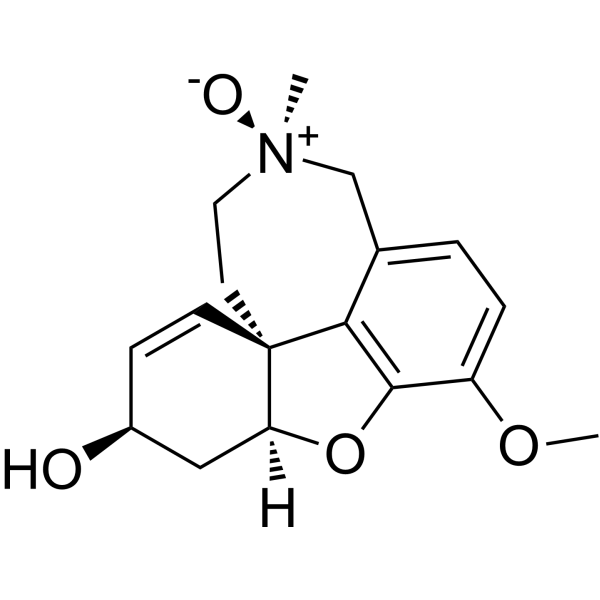
-
- HY-136300
-
-
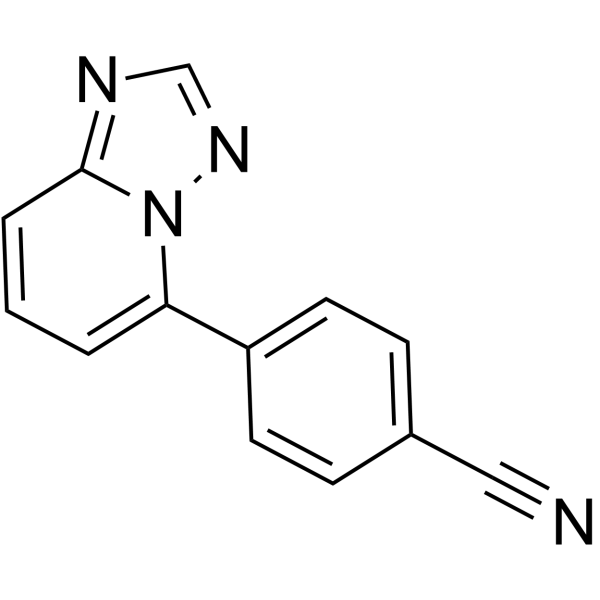
-
- HY-Y1750
-
|
BAPN
|
|
|
|
β-Aminopropionitrile (BAPN) is a specific, irreversible and orally active lysyl oxidase (LOX) inhibitor. β-Aminopropionitrile targets the active site of LOX or LOXL isoenzymes .
|
-
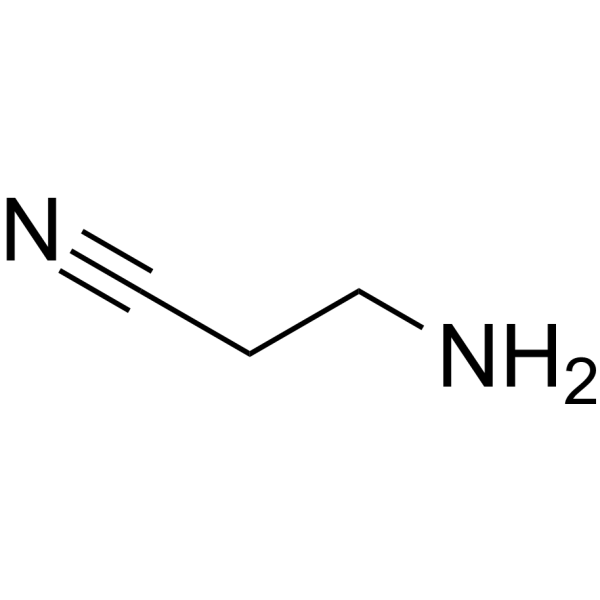
-
- HY-157527
-
|
|
Cholinesterase (ChE)
Beta-secretase
|
Neurological Disease
|
|
hAChE-IN-7 (compound 5s) is a mixed inhibitor affecting both the catalytic active site (CAS) and peripheral anionic site (PAS) of hAChE. hAChE-IN-7 displays the balanced inhibitory effect on hAChE (IC50=69.8 nM) and hBuChE (IC50=68.0 nM), and exhibits inhibitory activity against β-secretase-1 (BACE-1) (IC50=3.6 μM). hAChE-IN-7 has the potential for Alzheimer's disease (AD) research .
|
-
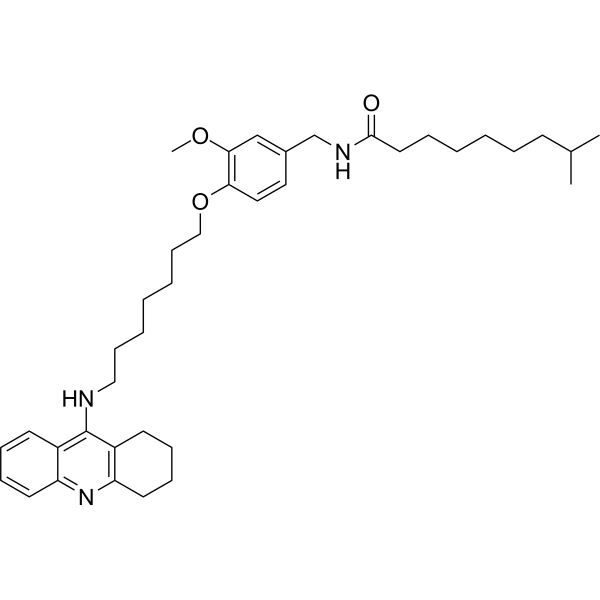
-
- HY-149484
-
|
|
Cholinesterase (ChE)
|
Neurological Disease
|
|
AChE/BChE-IN-15 (Compound 6d) is an AChE/BChE inhibitor, with IC50s of 20 nM and 220 nM respectively. AChE/BChE-IN-15 binds to both catalytic anionic site (CAS) and peripheral anionic site (PAS) in the active sites of AChE and BChE. AChE/BChE-IN-15 can be used for research of Alzheimer’s disease .
|
-

-
- HY-Y1750A
-
-

-
- HY-P5343
-
|
p53 Consensus binding sequence
|
MDM-2/p53
|
Others
|
|
p53 CBS (p53 Consensus binding sequence) is a biological active peptide. (p53 consensus DNA binding site)
|
-
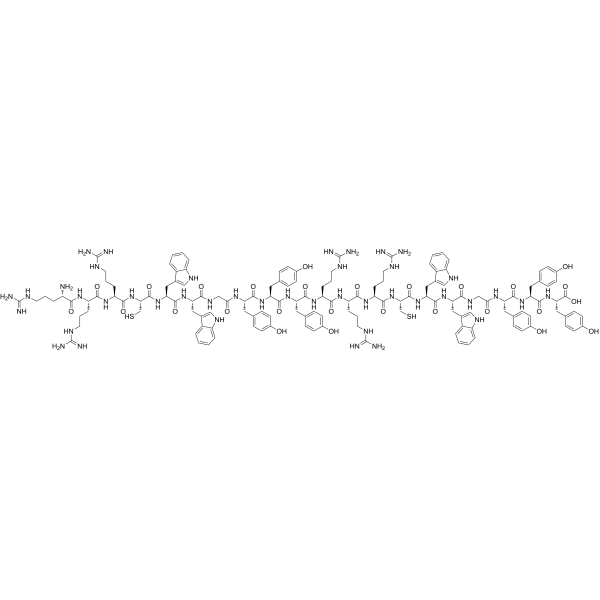
-
- HY-P2463
-
|
|
Arp2/3 Complex
|
Inflammation/Immunology
|
|
Fequesetide, a peptide segment, is the active site within the protein thymosin β4 responsible for actin binding, cell migration and wound healing .
|
-
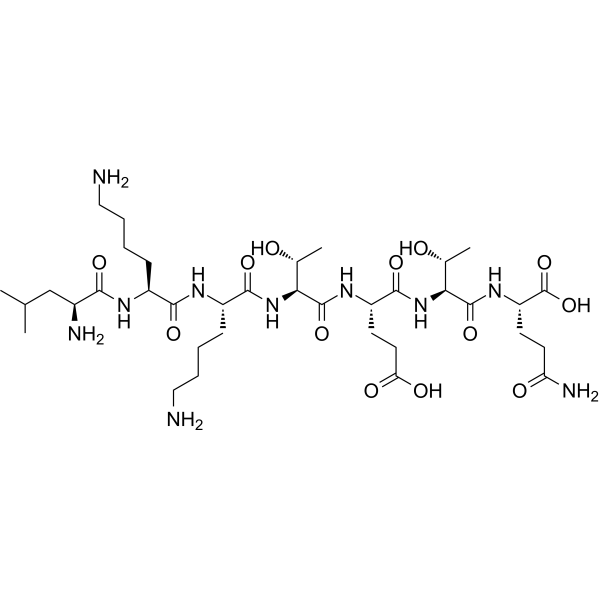
-
- HY-128379
-
|
|
Drug Metabolite
|
Others
|
|
Labetalone hydrochloride is an impurity of Labetalol. Labetalol is an orally active adrenoceptor blocking agent which is a competitive antagonist at both alpha- and beta-adrenoceptor sites .
|
-

-
- HY-15345
-
|
THU dihydrate; NSC-112907 dihydrate
|
Others
|
Cancer
|
|
Tetrahydrouridine dihydrate (THU dihydrate) is potent inhibitor of cytidine deaminase (CDA), which competitively blocks the enzyme's active site more effectively than intrinsic cytidine.
|
-
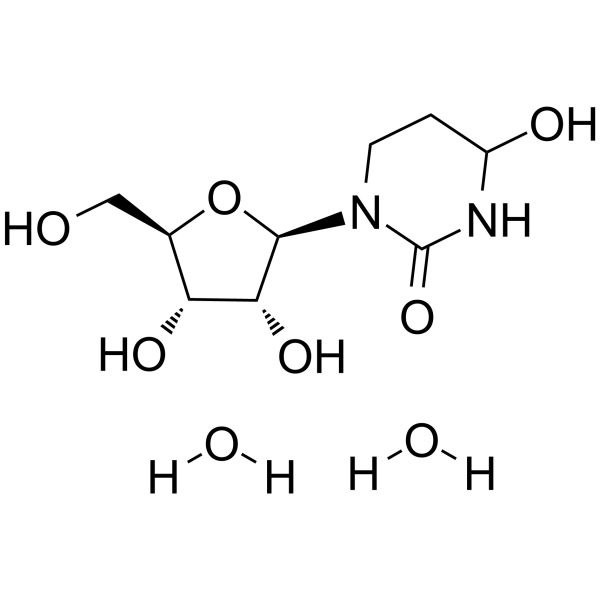
-
- HY-N7697C
-
|
|
Toll-like Receptor (TLR)
|
Inflammation/Immunology
|
|
Chitohexaose hexahydrochloride is a chitosan oligosaccharide with anti-inflammatory effect. Chitohexaose hexahydrochloride binds to the active sites of TLR4 and inhibits LPS induced inflammation .
|
-
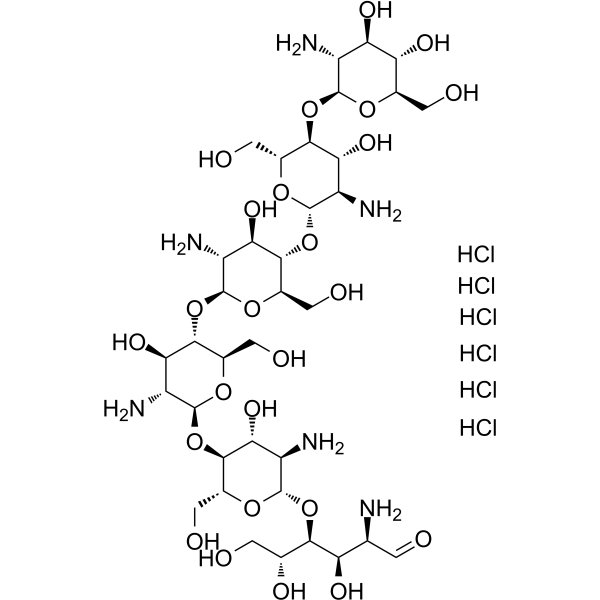
-
- HY-114753A
-
|
CR-2249 hydrochloride; XY-2401 hydrochloride
|
iGluR
|
Neurological Disease
|
|
Neboglamine (CR-2249, XY-2401) hydrochloride is an orally active NMDA receptor glycine site positive modulator that can be used in schizophrenia research .
|
-
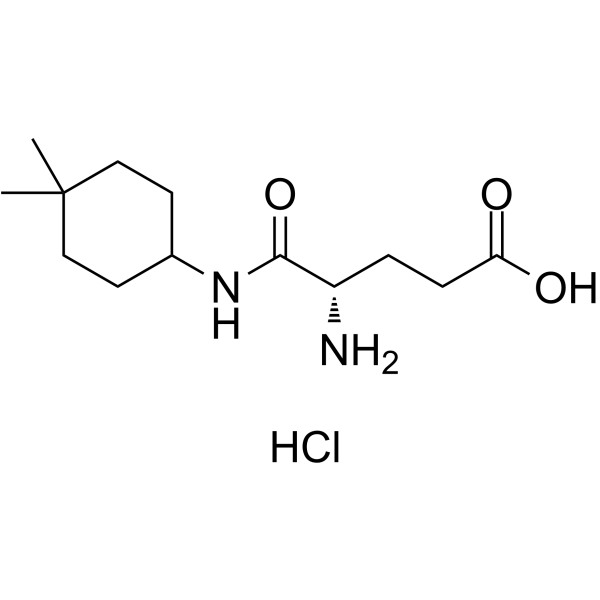
-
- HY-15345A
-
|
THU; NSC-112907
|
Others
|
Cancer
|
|
Tetrahydrouridine dihydrate is potent inhibitor of cytidine deaminase (CDA), which competitively blocks the enzyme's active site more effectively than intrinsic cytidine .
|
-
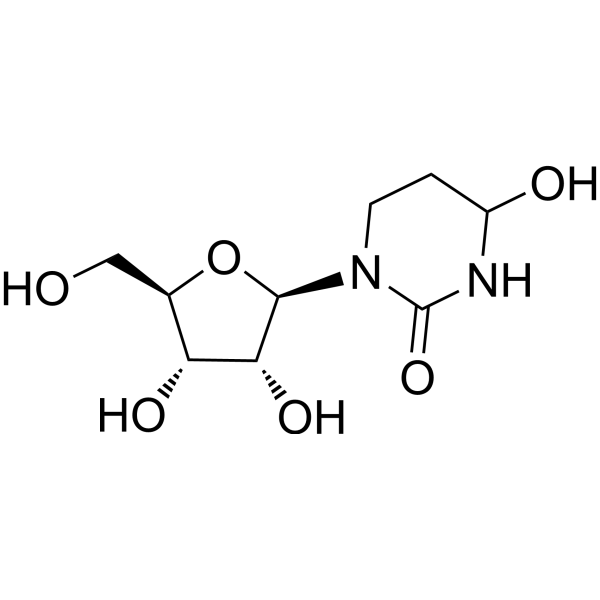
-
- HY-12062
-
|
|
MEK
|
Cancer
|
|
PD318088 is a potent, allosteric and non-ATP competitive MEK1/2 inhibitor, an analog of PD184352 (HY-50295). PD318088 binds simultaneously with ATP in a region of the MEK1 active site that is adjacent to the ATP-binding site. PD318088 can be used for cancer research .
|
-
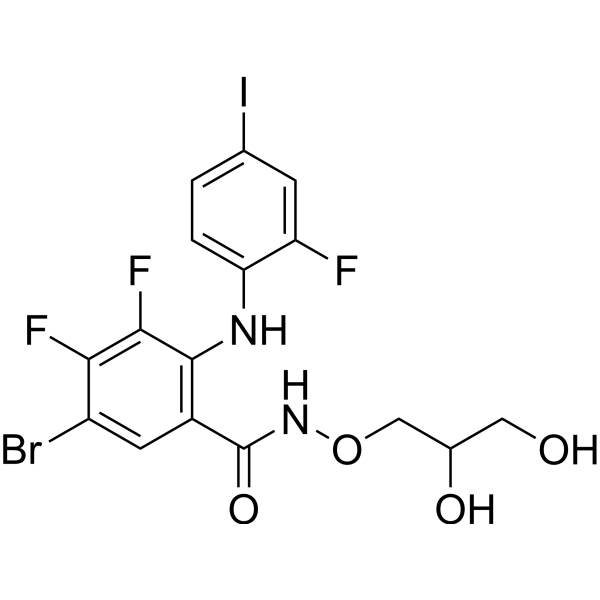
-
- HY-N2345
-
|
|
Histone Acetyltransferase
|
Cancer
|
|
Procyanidin B3 is a natural product, acts as a specific HAT inhibitor, binds to the other site of p300 instead of the active site, selectively inhibits p300-mediated androgen receptor acetylation. Procyanidin B3 has no effect on HDAC or HMT (histone methyltransferase) .
|
-

-
- HY-103334
-
-
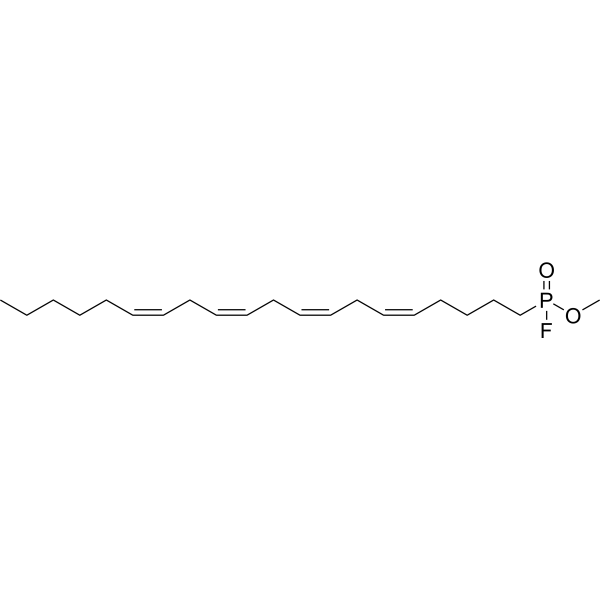
-
- HY-137431
-
|
BAY-2433334
|
Factor Xa
|
Cardiovascular Disease
|
|
Asundexian (BAY 2433334) is an orally active coagulation factor Xia (FXIa) inhibitor. Asundexian binds directly, potently, and reversibly to the active site of FXIa and thereby inhibits its activity. Asundexian inhibits human FXIa in buffer with an IC50 of 1 nM .
|
-

-
- HY-150728
-
|
|
Cholinesterase (ChE)
|
Neurological Disease
|
|
AChE-IN-22 (compound 10q) is a selective acetylcholinesterase (AChE) inhibitor against AChE and BuChE with the IC50 values of 0.88 μM and 10 μM, respectively. AChE-IN-22 can bind to both the CAS (catalytic active site) and PAS (peripheral anionic site) of AChE and has the potential for the research of Alzheimer's disease .
|
-
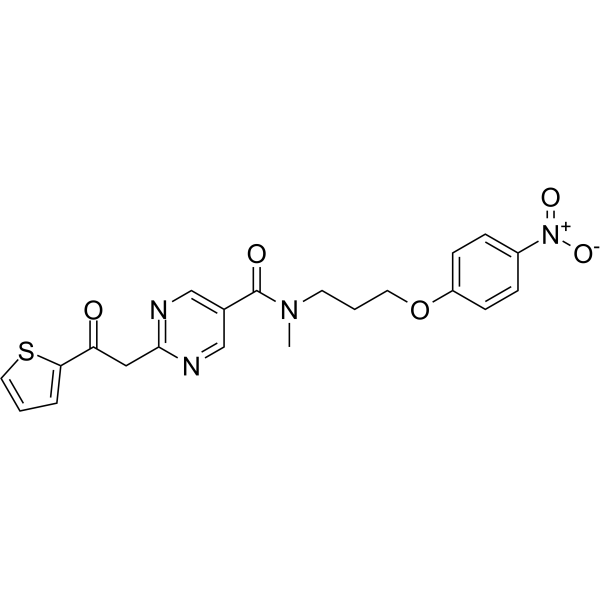
-
- HY-102087
-
JPM-OEt
3 Publications Verification
|
Cathepsin
|
Cancer
|
|
JPM-OEt is a broad spectrum cysteine cathepsin inhibitor. JPM-OEt binds covalently in the active site, and irreversibly inhibits the cysteine cathepsin family. Antitumor activity .
|
-
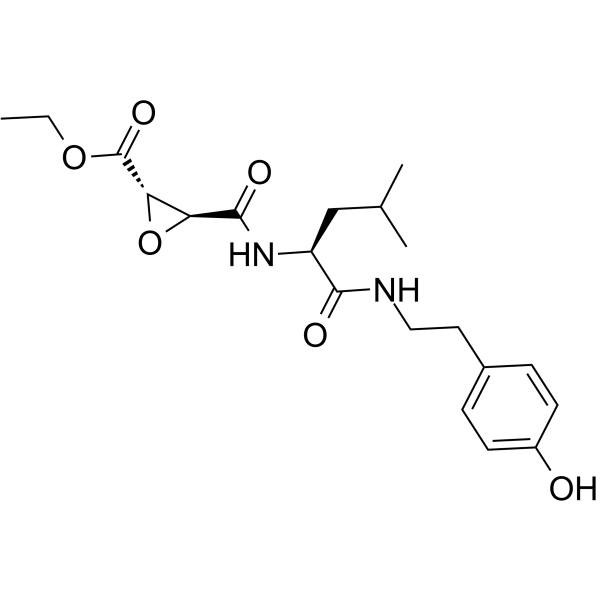
-
- HY-106968
-
|
|
iGluR
|
Neurological Disease
|
|
ZD-9379 is a potent, orally active, and brain penetrant full antagonist at the glycine site of the NMDA receptor. ZD-9379 has neuroprotective effect .
|
-
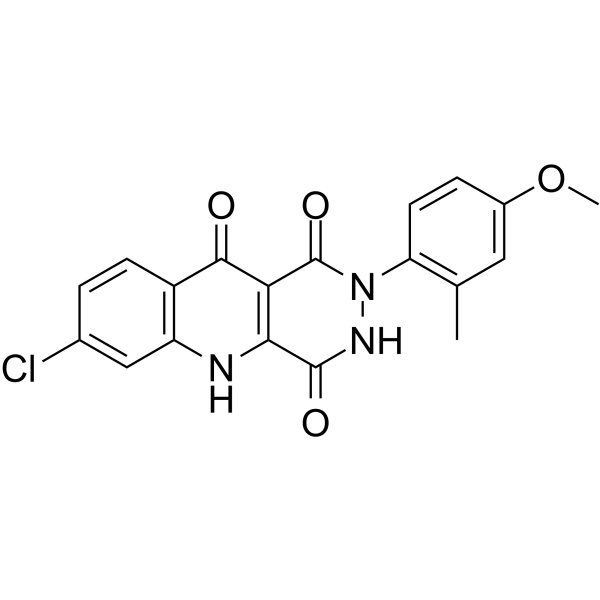
-
- HY-148433
-
|
|
Parasite
|
Infection
Inflammation/Immunology
|
|
SpdSyn binder-1 is a weak binder, which binds in the active site of plasmodium falciparum spermidine synthase. SpdSyn binder-1 can be used for the research of malaria .
|
-
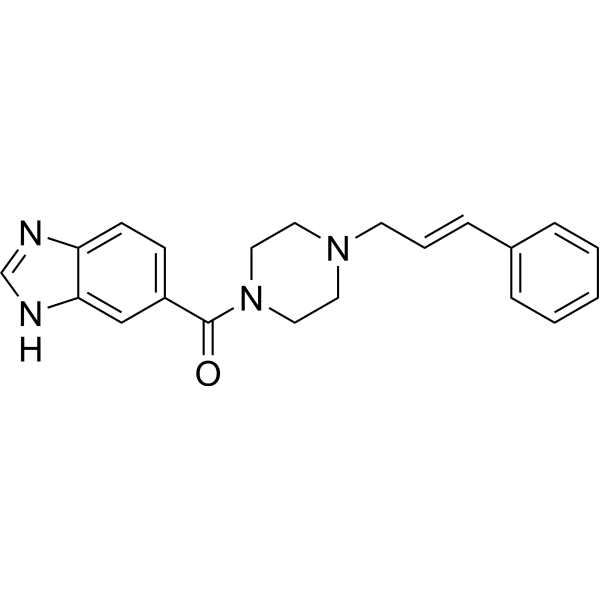
-
- HY-N7652
-
|
|
Bacterial
|
Infection
Inflammation/Immunology
|
|
Terminolic acid is a pentacyclic triterpenoid glucoside isolated from Combretum racemosum. Terminolic acid can inhibit the pro-inflammatory cytokines by binding to receptor active site of IL-1β and IL-6, and enhance anti-inflammatory cytokines by binding to IL-4 receptor binding sites. Terminolic acid also exhibits moderate antibacterial activity .
|
-
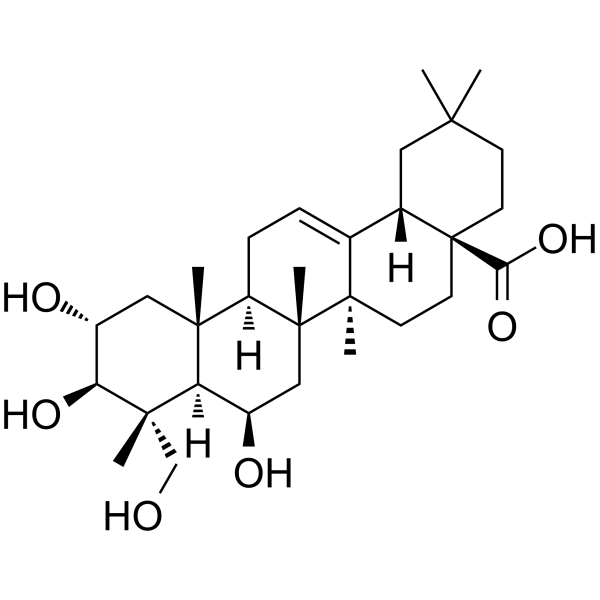
-
- HY-14617
-
Paradol
3 Publications Verification
[6]-Gingerone; [6]-Paradol
|
COX
|
Cancer
|
|
Paradol is a pungent phenolic substance found in ginger and other Zingiberaceae plants. Paradol is an effective inhibitor of tumor promotion in mouse skin carcinogenesis, binds to cyclooxygenase (COX)-2 active site.
|
-
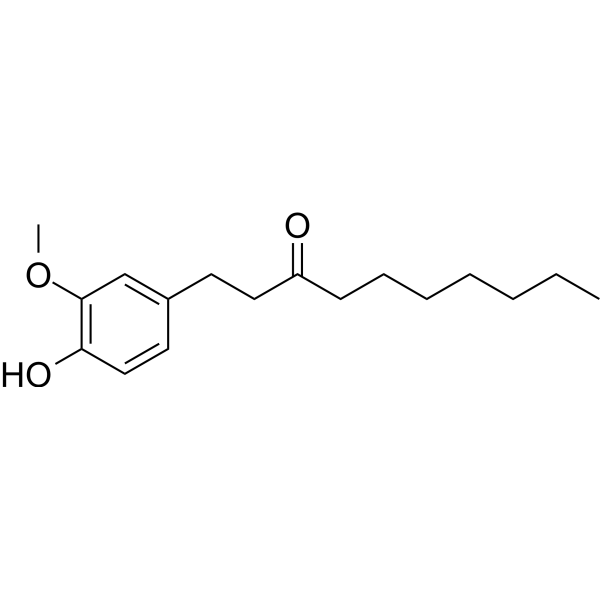
-
- HY-139032
-
-
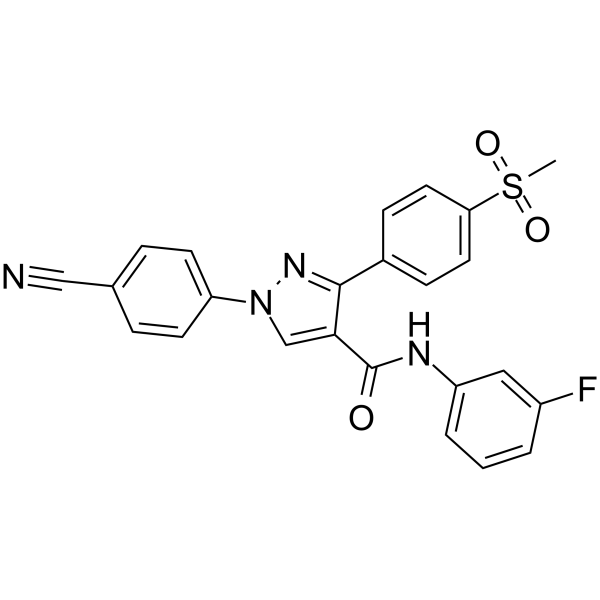
-
- HY-152156
-
|
|
Microtubule/Tubulin
Apoptosis
|
Cancer
|
|
Tubulin inhibitor 11 is a potent and orally active tubulin inhibitor. Tubulin inhibitor 11 targets the Colchicine binding site on tubulin, inhibits tubulin polymerization, promotes mitotic blockade and apoptosis .
|
-
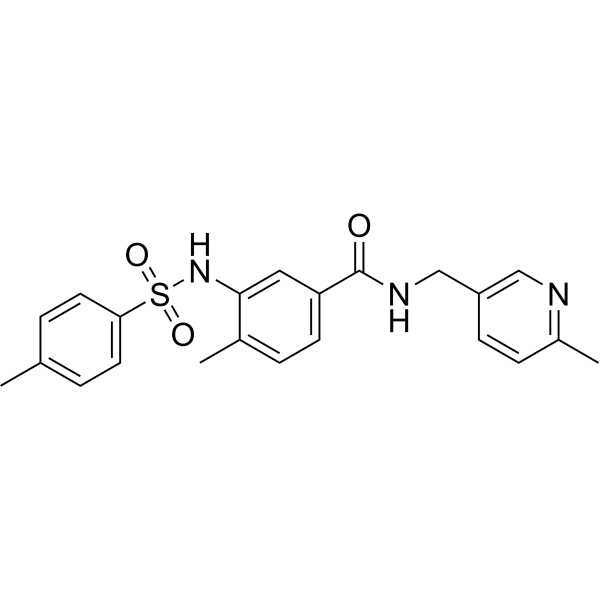
-
- HY-133154
-
|
CAIR; 4-Carboxy-AIR
|
Endogenous Metabolite
|
Infection
|
|
Carboxyaminoimidazole ribotide (CAIR) is a metabolite of E. coli. Carboxyaminoimidazole ribotide can be used to detect distinctive features of E. coli PurE active site and synthesis fungal de novo purine .
|
-
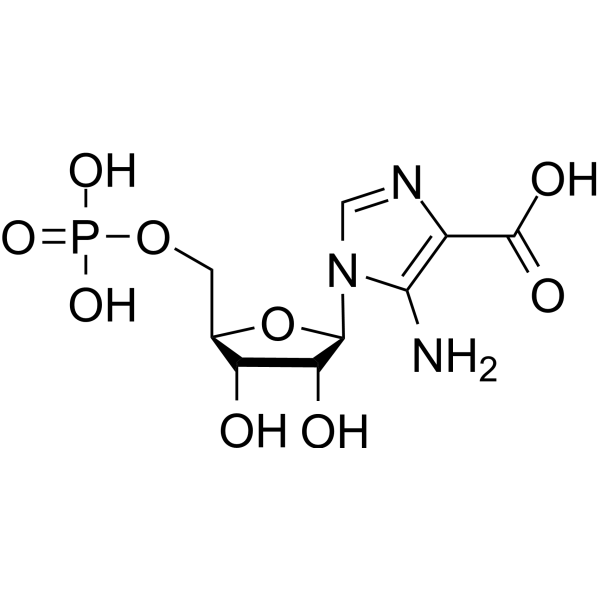
-
- HY-115749
-
|
6′-Methoxyluciferin
|
Others
|
Others
|
|
D-Luciferin 6′-methyl ether (6′-Methoxyluciferin; compound 19a) is a potent luciferase from the North American firefly Photinus pyralis (PpyLuc) inhibitor with an IC50 of 0.1 µM. D-Luciferin 6′-methyl ether, a D-luciferin analog, shows non-specific interactions at ATP- and luciferin-binding sites of the PpyLuc active site .
|
-
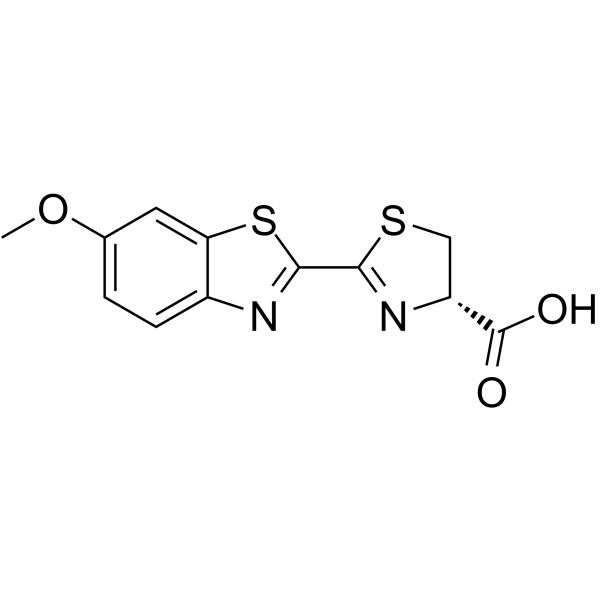
-
- HY-N11896A
-
-
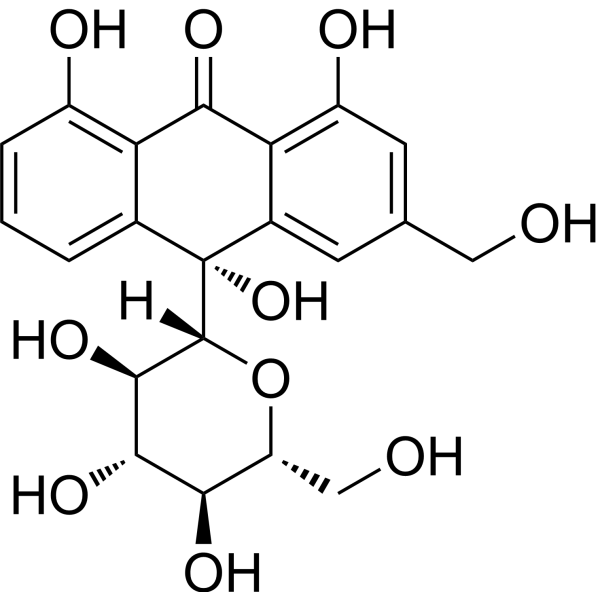
-
- HY-161137
-
|
|
Others
|
Neurological Disease
|
|
LQFM215 is a proline transporter (PROT) inhibitor. LQFM215 inhibits proline transport by competitively binding to the active site of PROT. LQFM215 effectively reduces hyperlocomotion and enhances social interaction .
|
-

-
- HY-119390
-
|
|
DNA Methyltransferase
|
Cancer
|
|
AA-CW236 is a MGMT (O6-methylguanine DNA methyltransferase) inhibitor. AA-CW236 targets MGMT active site Cys145 for covalent modification .
|
-

-
- HY-138825
-
|
|
Pyk2
|
Metabolic Disease
|
|
NCGC00188636 is a novel covalent pyruvate kinase (PYK) inhibitor. NCGC00188636 blocks nucleotide binding to the active site of pyruvate kinase. NCGC00188636 can be used for the research of the metabolism of many organisms and cell types.
|
-

-
- HY-115062
-
|
|
Phospholipase
|
Metabolic Disease
|
|
MJ33 is an active-site-directed, specific, competitive, and reversible phospholipase A2 (PLA2) inhibitor. MJ33 blocks the calcium-independent phospholipase A2 (iPLA2) activity of Prdx6 .
|
-

-
- HY-107700
-
|
GV 150526A
|
iGluR
|
Cardiovascular Disease
|
|
Gavestinel (GV 150526A) is a potent, selective, orally active and non-competitive antagonist of NMDA receptor. Gavestinel binds to the glycine site of the NMDA receptor, with a pKi of 8.5. Gavestinel can be used for the research of acute ischemic stroke .
|
-
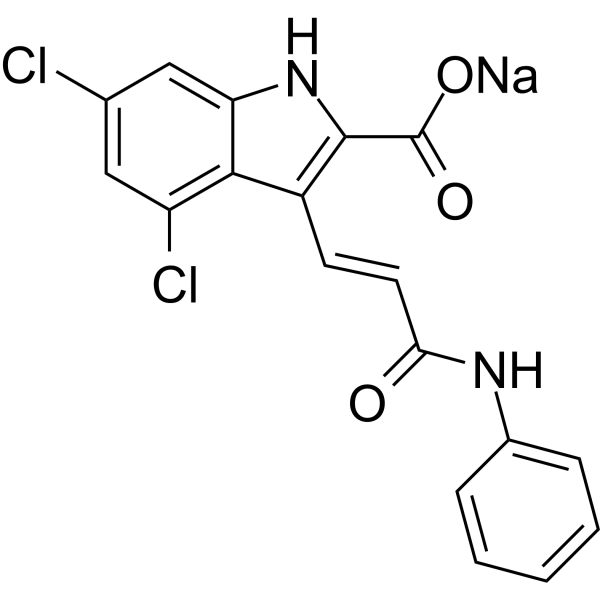
-
- HY-120634
-
|
|
HCV
|
Infection
|
|
BMS-929075 is a potent and orally active HCV NS5B replicase palm site allosteric inhibitor. BMS-929075 shows high oral bioavailability. BMS-929075 shows cytotoxicity .
|
-

-
- HY-18081
-
|
|
FAAH
Autophagy
|
Metabolic Disease
|
|
PF 750 is a selective and covalent fatty acid amide hydrolase (FAAH) inhibitor, with IC50s varied from 16.2-595 nM in different pre-incubation times. Covalently modifies the enzyme’s active site serine nucleophile .
|
-
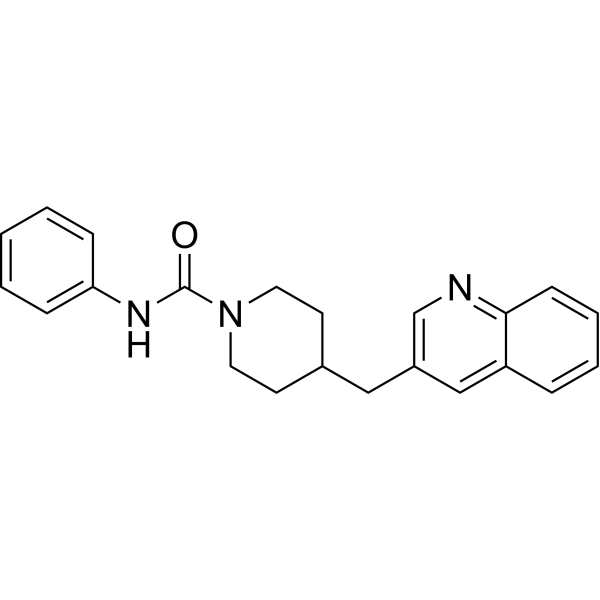
-
- HY-N1419
-
|
|
|
|
|
Vaccarin is an active flavonoid glycoside associated with various biological functions. Vaccarin significantly promote wound healing and endothelial cells and fibroblasts proliferation in the wound site. Vaccarin ameliorates insulin resistance and steatosis by activating the AMPK signaling pathway .
|
-

-
- HY-139031
-
-
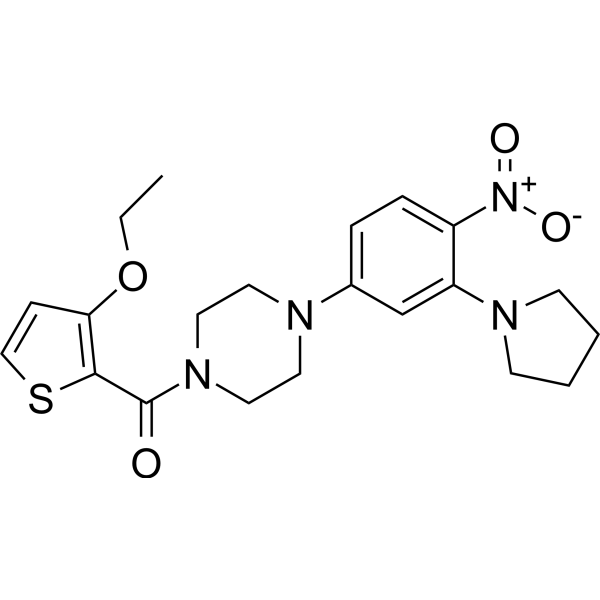
-
- HY-15345AS
-
|
THU-d3; NSC-112907-d3
|
Isotope-Labeled Compounds
|
Cancer
|
|
Tetrahydrouridine-d3 is the deuterium labeled Tetrahydrouridine[1]. Tetrahydrouridine dihydrate is potent inhibitor of cytidine deaminase (CDA), which competitively blocks the enzyme's active site more effectively than intrinsic cytidine[2][3].
|
-

-
- HY-P5455
-
|
|
LIM Kinase (LIMK)
|
Others
|
|
S3 Fragment is a biological active peptide. (This peptide contains the unique amino-terminal phosphorylation site of Xenopus ADF/cofilin, the LIM kinase (LIMK) phosphorylation site. LIMK1 is a key regulator of the actin cytoskeleton through its phosphorylation of ADF/cofilin at serine-3 for inactivation. This peptide is a fragment of the S3 peptide containing the serine-3 sequence of ADF/cofilin that has been widely used as an effective competitive inhibitor of LIMK1.)
|
-

-
- HY-123834
-
|
|
FLAP
|
Cancer
|
|
FEN1-IN-1 (compound 1) is a flap endonuclease 1 (FEN1) inhibitor. FEN1-IN-1 binds to the active site of FEN1 and partly achieves inhibition by the co-ordination of Mg 2+ ions .
|
-
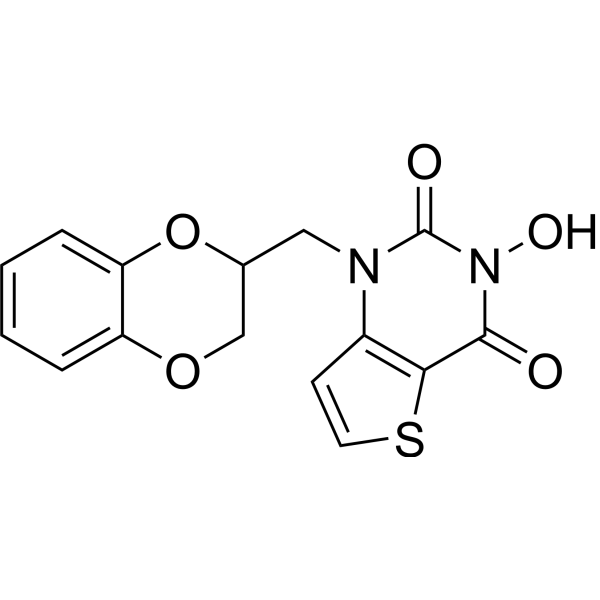
-
- HY-116750
-
|
|
Tyrosinase
|
Others
|
|
6-Hydroxykaempferol, a flavonoid, is a competitive tyrosinase inhibitor with an IC50 value of 124 μM. 6-Hydroxykaempferol has a Ki value of 148 μM relative to L-DOPA as a substrate and effectively inhibits the activity of the enzyme by binding to the active site of the enzyme .
|
-
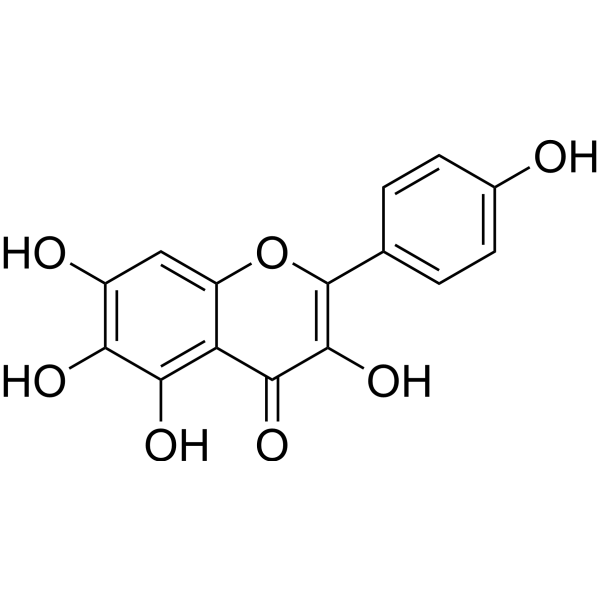
-
- HY-142021
-
|
|
Parasite
|
Infection
|
|
Z-Leu-Arg-AMC is a 4-methylcoumarinyl-7-amide (Amc) leucine derivative with carboxybenzoyl (Z). Z-Leu-Arg-AMC is the active site of cysteine proteinase trypanopain-Tb from Trypanosoma brucei brucei .
|
-
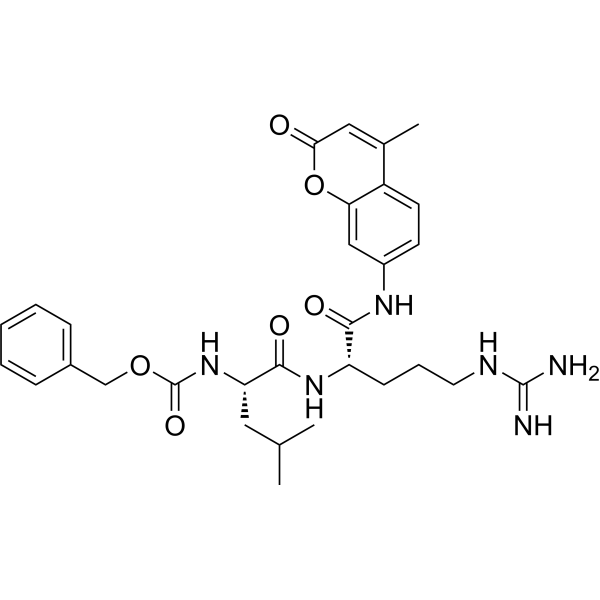
-
- HY-123054
-
BTSA1
1 Publications Verification
|
Bcl-2 Family
Apoptosis
|
Cancer
|
|
BTSA1 is a potent, high affinity and orally active BAX activator with an IC50 of 250 nM and an EC50 of 144 nM. BTSA1 binds with high affinity and specificity to the N-terminal activation site and induces conformational changes to BAX leading to BAX-mediated apoptosis .
|
-

-
- HY-A0068
-
|
Gold thioglucose
|
NF-κB
HIV
Reactive Oxygen Species
|
Infection
Inflammation/Immunology
Cancer
|
|
Aurothioglucose (Gold thioglucose), containing monovalent gold ion, is a potent active-site inhibitor of TrxR1 (thioredoxin reductase 1), with an IC50 of 65 nM. Aurothioglucose inhibits the DNA binding of NF-κB in vitro. Aurothioglucose shows anti-HIV and anti-rheumatic activities .
|
-

-
- HY-108419
-
|
|
JNK
|
Cancer
|
|
WHI-P258, a quinazoline compound, binds to the active site of JAK3 with an estimated Ki of 72 µM. WHI-P258 does not inhibit JAK3 and does not affect the thrombin-induced aggregation of platelets even at 100 μM .
|
-
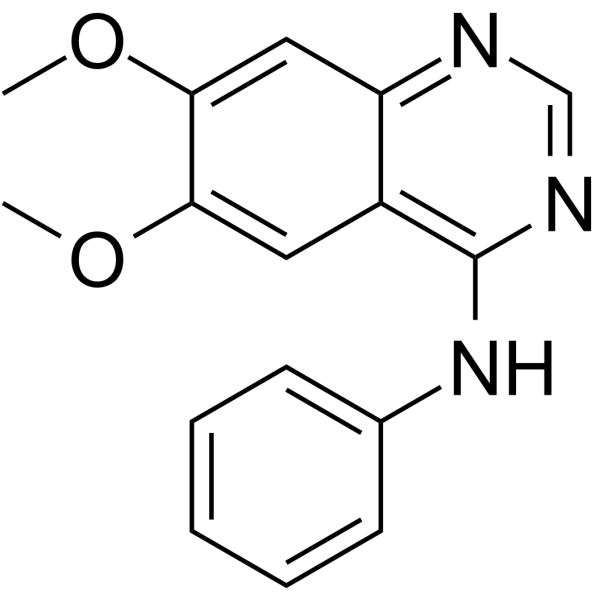
-
- HY-124832
-
|
|
Caspase
Amyloid-β
|
Neurological Disease
|
|
δ-Secretase inhibitor 11 (compound 11) is an orally active, potent, BBB-penetrated, non-toxic, selective and specific δ-secretase inhibitor, with an IC50 of 0.7 μM. δ-Secretase inhibitor 11 interacts with both the active site and allosteric site of δ-secretase. δ-Secretase inhibitor 11 attenuates tau and APP (amyloid precursor protein) cleavage. δ-Secretase inhibitor 11 ameliorates synaptic dysfunction and cognitive impairments in tau P301S and 5XFAD transgenic mouse models. δ-Secretase inhibitor 11 can be used for Alzheimer's disease research .
|
-

-
- HY-P99298
-
|
RG 7417; TNX 234; Anti-CFD Recombinant Antibody
|
Complement System
|
Inflammation/Immunology
|
|
Lampalizumab (RG 7417) is a humanised monoclonal antibody targeting complement Factor D in the alternative complement pathway. Lampalizumab binds an exosite and sterically blocks Factor B access to the active site. Lampalizumab can be used for age-related macular degeneration (AMD) research .
|
-

-
- HY-N1066
-
|
|
|
|
|
Xanthohumol D, isolated from hops, is an inhibitor of quinone reductase-2 (QR-2) with the IC50 value of 110 μM, and binds to the active site of QR-2. Xanthohumol D shows antiproliferative activity on human cancer cell lines in vitro .
|
-
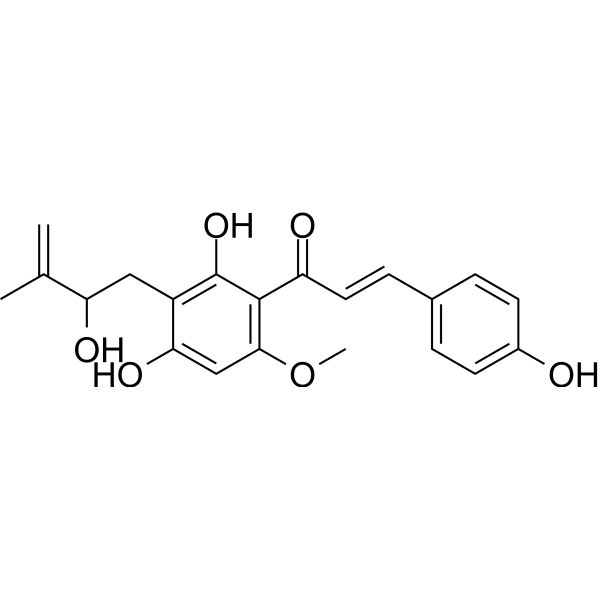
-
- HY-137028
-
|
PD157432
|
EGFR
|
Cancer
|
|
2'-Thioadenosine (PD157432) is a selective and irreversible inhibitor of ErbB-1 and ErbB-2, with an IC50 of 45 µM for ErbB-2. 2'-Thioadenosine covalently inactivates ErbB-1 via modification of a cysteine residue at the active site .
|
-
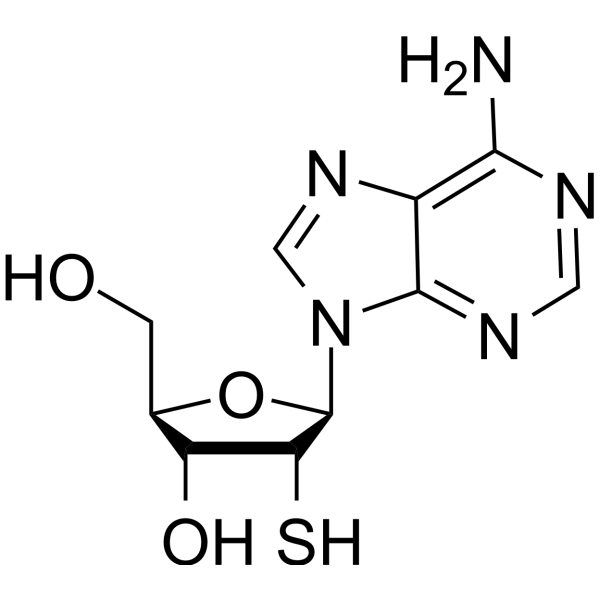
-
- HY-12903
-
|
PBTZ169
|
Bacterial
Antibiotic
|
Infection
|
|
Macozinone (PBTZ169) is a bactericidal benzothiazinone and a potent DprE1 (decaprenylphosphoryl-β-d-ribose 2′-oxidase) inhibitor. Macozinone inhibits the essential flavoprotein DprE1 by forming a covalent bond with the active-site Cys387 residue. Macozinone has antituberculosis effect .
|
-
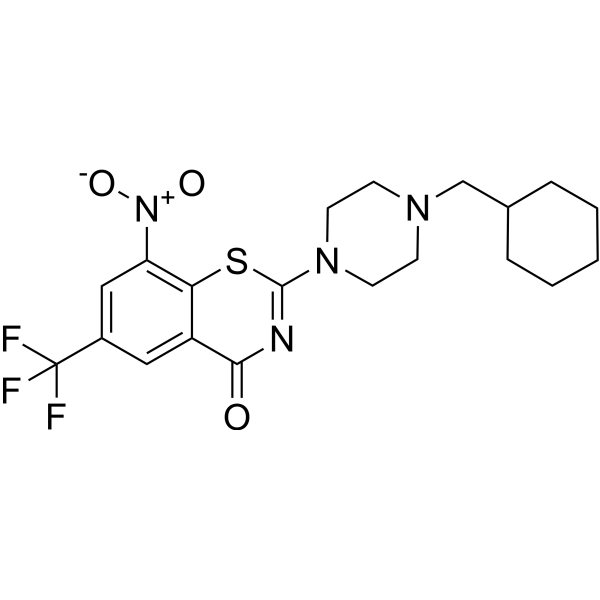
- HY-112299
-
|
TAS6417; CLN-081
|
EGFR
Apoptosis
|
Cancer
|
|
Zipalertinib (TAS6417; CLN-081) is a highly effective, orally active and pan-mutation-selective EGFR tyrosine kinase inhibitor with a unique scaffold fitting into the ATP-binding site of the EGFR hinge region, with IC50 values ranging from 1.1-8.0 nM .
|
-

- HY-129944
-
|
|
Phospholipase
|
Inflammation/Immunology
|
|
MJ33-OH is a metabolite of MJ33. MJ33 is an active-site-directed, specific, competitive, and reversible phospholipase A2 (PLA2) inhibitor. MJ33 blocks the calcium-independent phospholipase A2 (iPLA2) activity of Prdx6 .
|
-
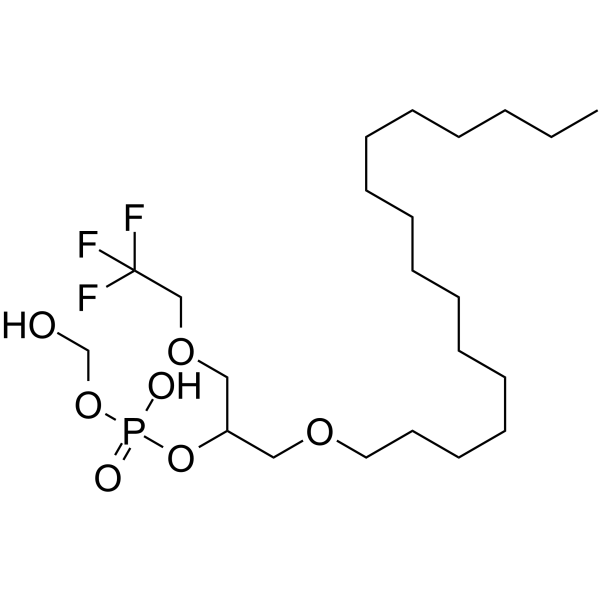
- HY-N7136
-
|
|
Cytochrome P450
|
Metabolic Disease
|
|
α-Terpinyl acetate is a monoterpene ester isolated from Laurus nobilis L. essential oil. α-Terpinyl acetate is a competitive P450 2B6 substrate which binding to the active site of P450 2B6 with a Kd value of 5.4 μM .
|
-
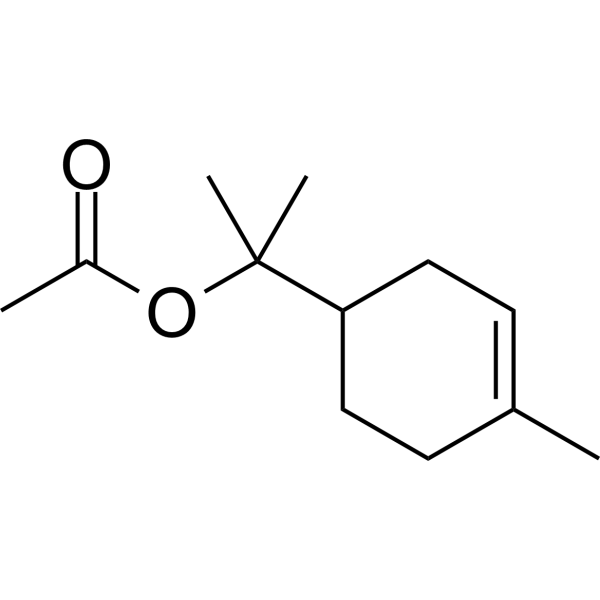
- HY-129944A
-
|
|
Phospholipase
|
Inflammation/Immunology
|
|
MJ33-OH lithium is a metabolite of MJ33. MJ33 is an active-site-directed, specific, competitive, and reversible phospholipase A2 (PLA2) inhibitor. MJ33 blocks the calcium-independent phospholipase A2 (iPLA2) activity of Prdx6 .
|
-

- HY-B0849
-
|
|
Fungal
Reactive Oxygen Species
Apoptosis
Bacterial
Phosphatase
|
Infection
|
|
Azoxystrobin is an orally active, broad-spectrum β-methoxyacrylate fungicide. Azoxystrobin inhibits mitochondrial respiration by binding to the Qo site of the cytochrome bc1 complex and inhibiting electron transfer. Azoxystrobin induces the production of reactive oxygen species (ROS) and induces cell apoptosis .
|
-

- HY-P0266B
-
|
Ac-SDKP acetate
|
Angiotensin-converting Enzyme (ACE)
|
Inflammation/Immunology
|
|
N-Acetyl-Ser-Asp-Lys-Pro (Ac-SDKP) acetate is a specific substrate for the N-terminal active site of angiotensin-converting enzyme (ACE). N-Acetyl-Ser-Asp-Lys-Pro acetate is a natural inhibitor of pluripotent hematopoietic stem cell proliferation. Anti-inflammatory and antifibrotic properties .
|
-
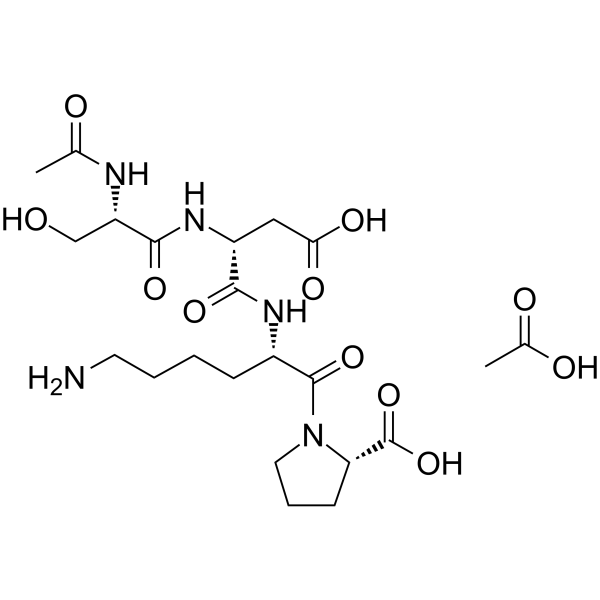
- HY-149241
-
|
|
SHP2
|
Cancer
|
|
SHP2-IN-13 is a highly selective and orally active SHP2 “tunnel site” allosteric inhibitor with an IC50 of 83.0 nM. SHP2-IN-13 has the potential for cancers bearing RTK oncogenic drivers and SHP2-related diseases research.
|
-

- HY-120110
-
IOX4
5 Publications Verification
|
HIF/HIF Prolyl-Hydroxylase
|
Neurological Disease
Inflammation/Immunology
|
|
IOX4 is a selective HIF prolyl-hydroxylase 2 (PHD2) inhibitor with an IC50 value of 1.6 nM, induces HIFα in cells and in wildtype mice with marked induction in the brain tissue. IOX4 competes with and displaces 2-oxoglutarate (2OG) at the active site of PHD2 .
|
-
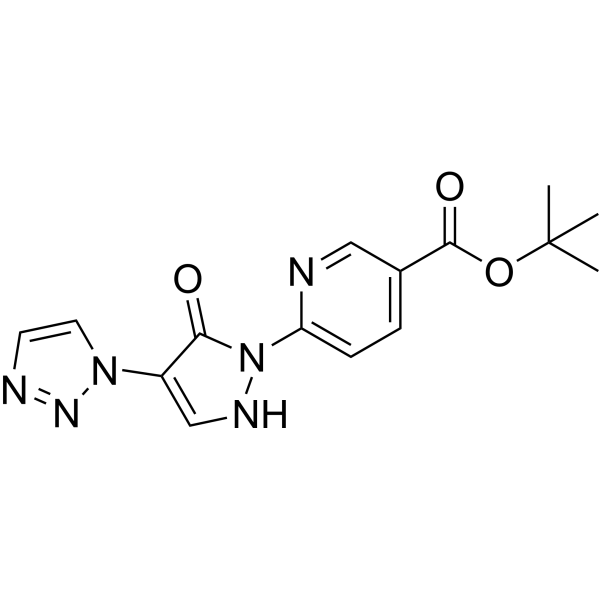
- HY-109012A
-
|
JNJ-42847922 hydrochloride
|
Orexin Receptor (OX Receptor)
|
Neurological Disease
Endocrinology
|
|
Seltorexant hydrochloride (JNJ-42847922 hydrochloride) is an orally active, high-affinity, and selective OX2R antagonist (pKi values of 8.0 and 8.1 for human and rat OX2R). Seltorexant hydrochloride crosses the blood-brain barrier and quickly occupies OX2R binding sites in the rat brain .
|
-
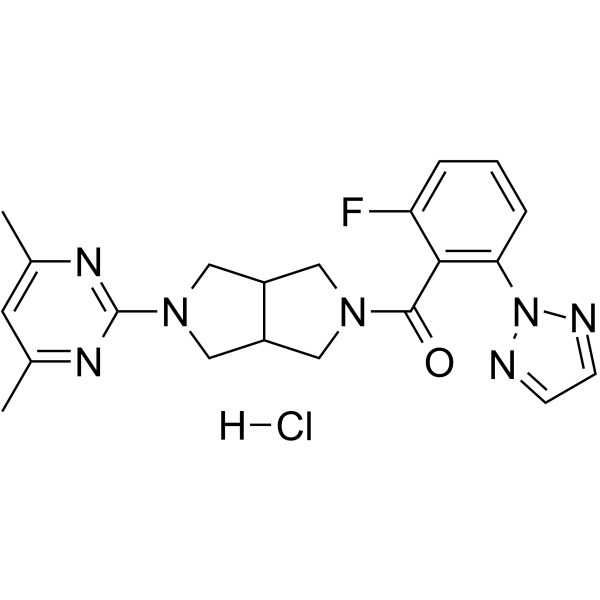
- HY-160564
-
|
|
EGFR
|
Cancer
|
|
ZNL-0056 is an orally active ATP-competitive inhibitor that targets both the Cys797 and Cys775 in the ATP binding site of EGFR. ZNL-0056 selectively inhibits EGFR and its downstream signaling in H3255 cells. ZNL-0056 can be used for the research of cancer .
|
-
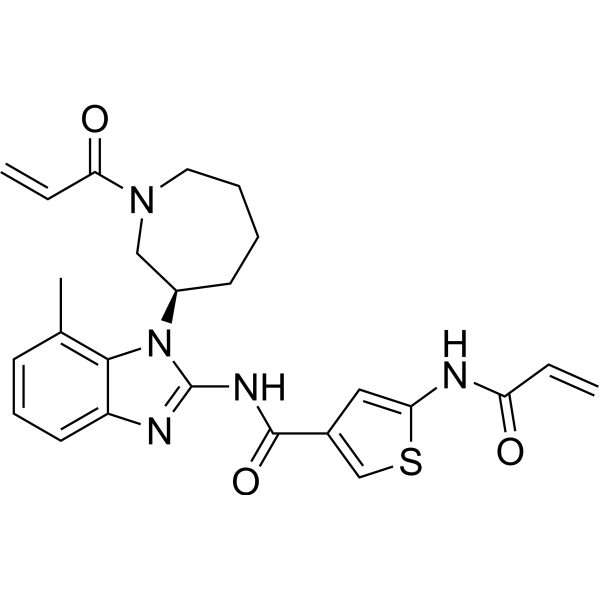
- HY-13642
-
|
N-Phthalyl-L-tryptophan
|
DNA Methyltransferase
|
Cancer
|
|
RG108 (N-Phthalyl-L-tryptophan) is a non-nucleoside DNA methyltransferases (DNMTs) inhibitor (IC50=115 nM) that blocks the DNMTs active site. RG108 (N-Phthalyl-L-tryptophan) causes demethylation and reactivation of tumor suppressor genes, but it does not affect the methylation of centromeric satellite sequences .
|
-
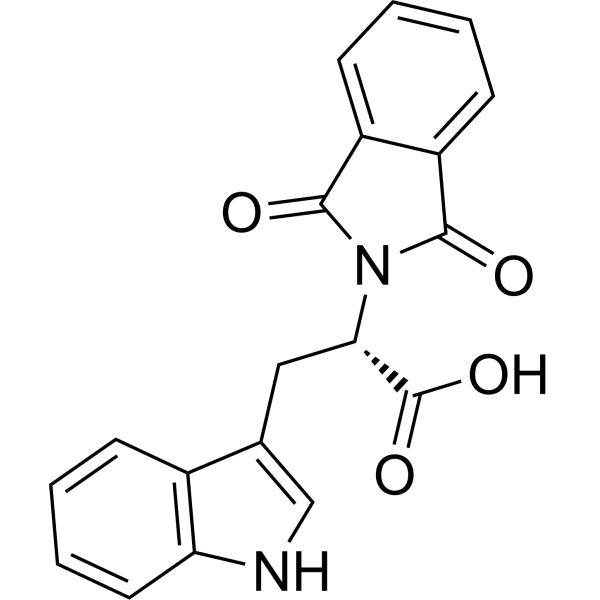
- HY-18698
-
|
|
iGluR
|
Neurological Disease
|
|
L-701324 is a potent, orally active NMDA receptor antagonist that antagonizes the activity of the NMDA receptor by blocking its glycine B binding site. L-701324 binds with high affinity to rat brain membranes (IC50=2 nM). L-701324 has antidepressant activity .
|
-
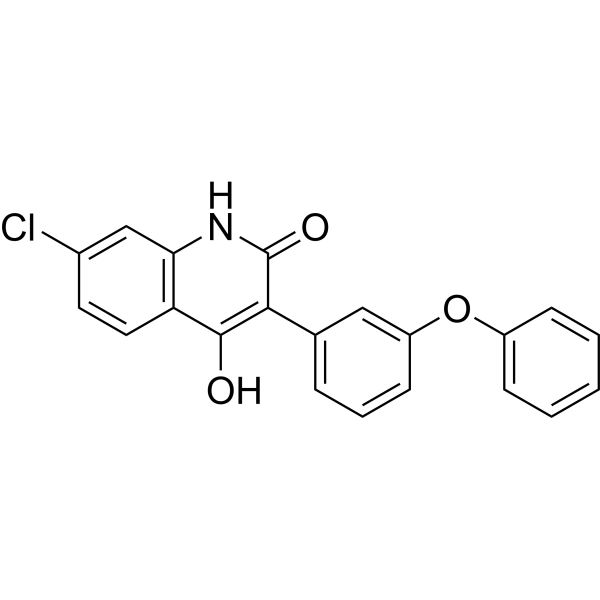
- HY-128778
-
|
|
EGFR
|
Cancer
|
|
DBPR112 is an orally active furanopyrimidine-based EGFR inhibitor with IC50s of 15 nM and 48 nM for EGFR WT and EGFR L858R/T790M, respectively. DBPR112 can occupy the ATP-binding site. DBPR112 has significant antitumor efficacy .
|
-
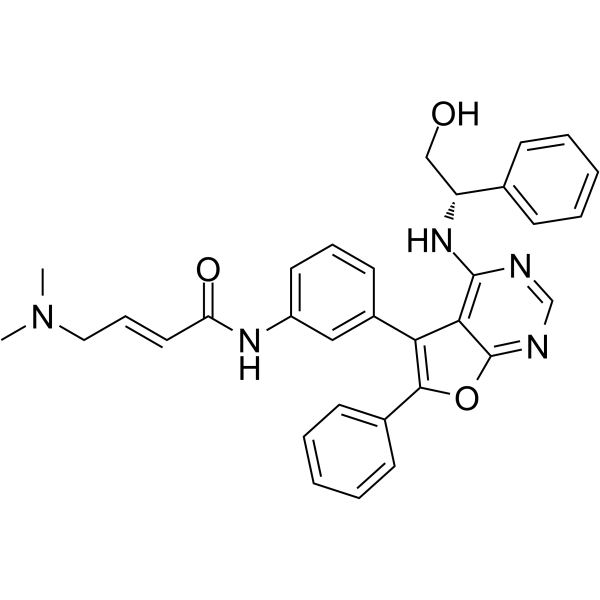
- HY-19151
-
|
IS-741
|
Integrin
Phospholipase
|
Inflammation/Immunology
|
|
Fuzapladib (IS-741), an orally active leukocyte-function-associated antigen type 1 (LFA-1) activation inhibitor, is a leukocyte adhesion molecule. Fuzapladib is also a phospholipase A2 (PLA2) inhibitor. Fuzapladib exerts anti-inflammatory effects by inhibiting leukocyte migration into the inflammatory site .
|
-
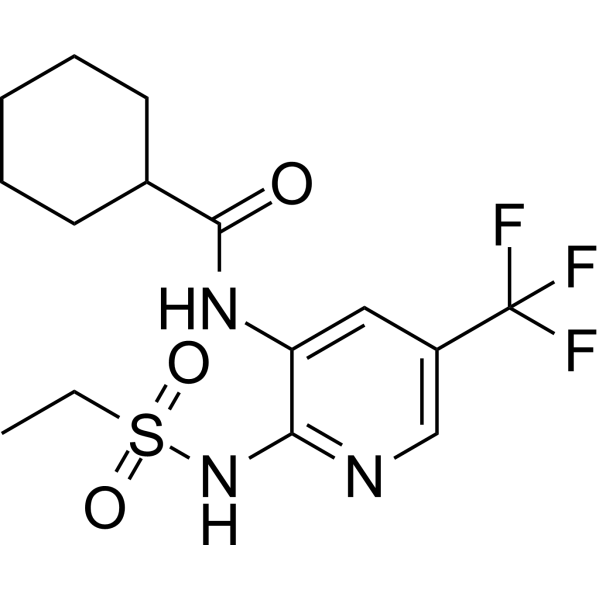
- HY-D1188
-
|
|
PARP
|
Cancer
|
|
PARP7-probe-1 is a chemiluminescent labeled PARP7 probe. PARP7-probe-1 is a biotinylated probe binding to the PARP7 active site. PARP7-probe-1 can be used for the research of PARP7 function .
|
-
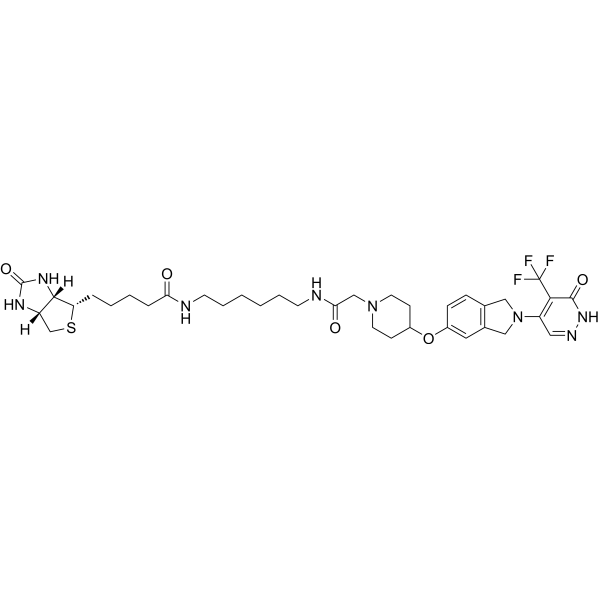
- HY-19151A
-
|
IS-741 sodium
|
Integrin
Phospholipase
|
Inflammation/Immunology
|
|
Fuzapladib (IS-741) sodium, an orally active leukocyte-function-associated antigen type 1 (LFA-1) activation inhibitor, is a leukocyte adhesion molecule. Fuzapladib sodium is also a phospholipase A2 (PLA2) inhibitor. Fuzapladib sodium exerts anti-inflammatory effects by inhibiting leukocyte migration into the inflammatory site .
|
-
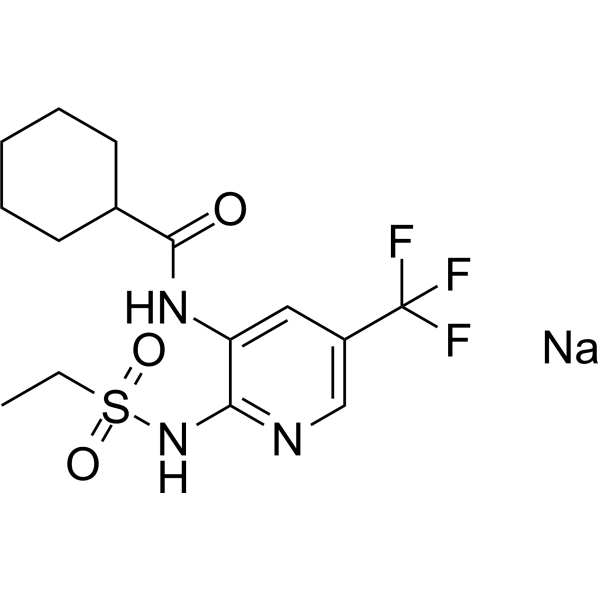
- HY-100433
-
|
|
PDI
|
Cancer
|
|
PACMA 31 is an irreversible, orally active protein disulfide isomerase (PDI) inhibitor with an IC50 of 10 μM. PACMA 31 forms a covalent bond with the active site cysteines of PDI. PACMA 31 shows tumor targeting ability and significantly suppresses ovarian tumor growth without causing toxicity to normal tissues . PACMA 31 is a click chemistry reagent, it contains an Alkyne group and can undergo copper-catalyzed azide-alkyne cycloaddition (CuAAc) with molecules containing Azide groups.
|
-
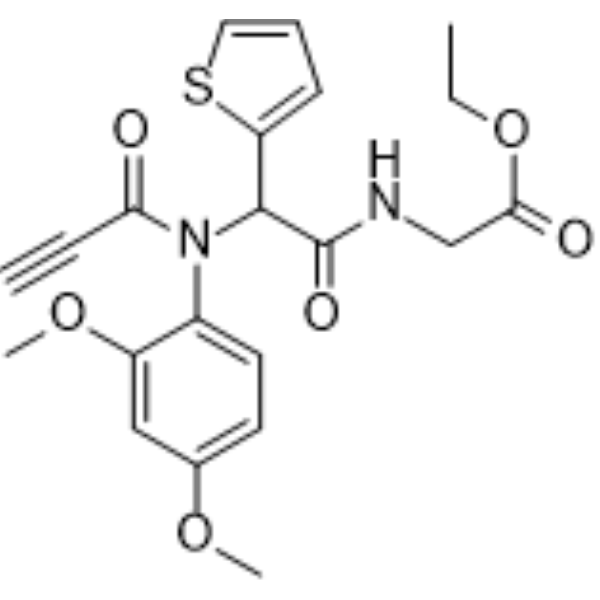
- HY-116749
-
|
BBSKE
|
TrxR
|
Cancer
|
|
Ethaselen (BBSKE) is an orally active, selective thioredoxin reductase (TrxR) inhibitor with IC50s of 0.5 and 0.35 μM for the wild-type human TrxR1 and rat TrxR1, respectively. Ethaselen specifically binds to the unique selenocysteine-cysteine redox pair in the C-terminal active site of mammalian TrxR1. Ethaselen, an organoselenium compound, is a potent antitumor candidate that exerts potent inhibition on non-small cell lung cancer (NSCLC) by targeting TrxR .
|
-

- HY-123587
-
|
|
Proteasome
Apoptosis
|
Cancer
|
|
PR-924 is a selective tripeptide epoxyketone immunoproteasome subunit LMP-7 inhibitor with an IC50 of 22 nM. PR-924 covalently modifies proteasomal N-terminal threonine active sites. PR-924 inhibits growth and triggers apoptosis in multiple myeloma (MM) cells. PR-924 has antitumor activities .
|
-
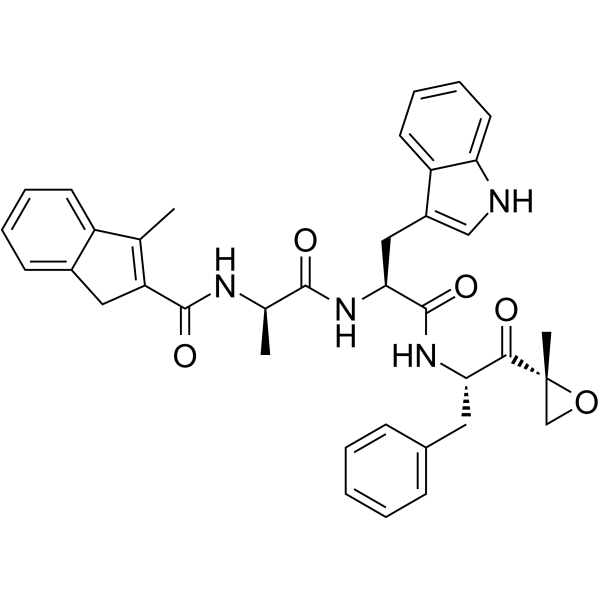
- HY-14336
-
|
|
5-HT Receptor
|
Neurological Disease
|
|
SB 271046 is a potent, selective and orally active 5-HT6 receptor antagonist with a pKi of 8.92-9.09. SB 271046 show >200-fold selective for the 5-HT6 receptor over other receptors, binding sites and ion channels. SB 271046 has anticonvulsant activity .
|
-
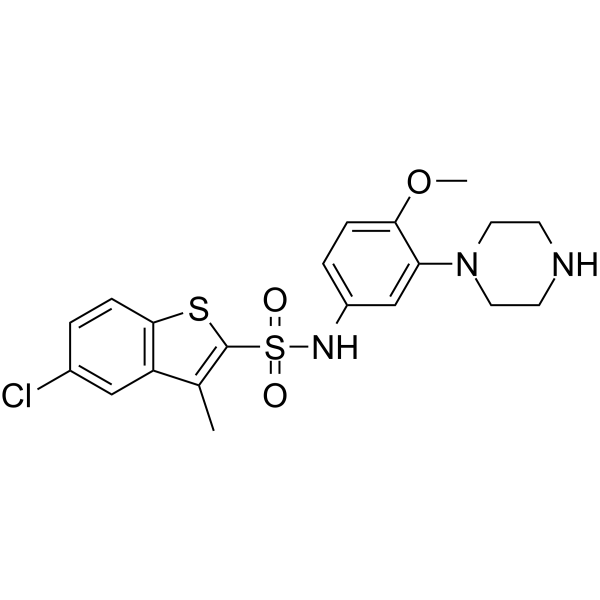
- HY-A0068R
-
|
Gold thioglucose (Standard)
|
NF-κB
HIV
Reactive Oxygen Species
|
Infection
Inflammation/Immunology
Cancer
|
|
Aurothioglucose (Standard) is the analytical standard of Aurothioglucose. This product is intended for research and analytical applications. Aurothioglucose (Gold thioglucose), containing monovalent gold ion, is a potent active-site inhibitor of TrxR1 (thioredoxin reductase 1), with an IC50 of 65 nM. Aurothioglucose inhibits the DNA binding of NF-κB in vitro. Aurothioglucose shows anti-HIV and anti-rheumatic activities .
|
-
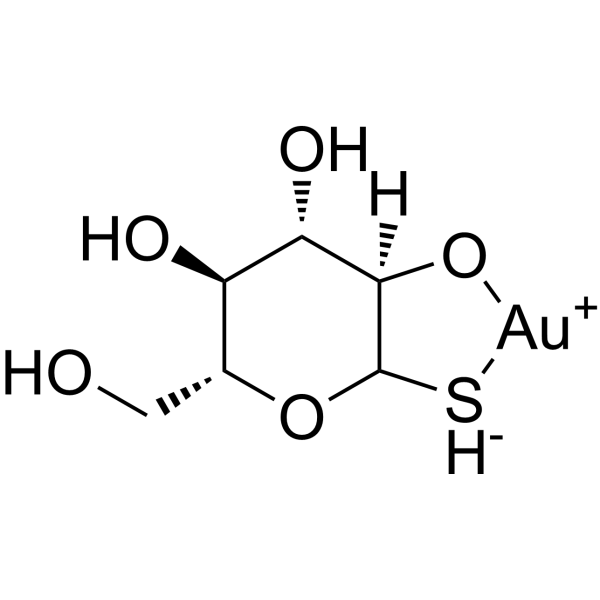
- HY-16658
-
Z-VAD(OMe)-FMK
Maximum Cited Publications
154 Publications Verification
Z-Val-Ala-Asp(OMe)-FMK
|
Caspase
|
Cancer
|
|
Z-VAD(OMe)-FMK (Z-Val-Ala-Asp(OMe)-FMK) is a cell-permeable and irreversible pan-caspase inhibitor . Z-VAD(OMe)-FMK is an ubiquitin carboxy-terminal hydrolase L1 (UCHL1) inhibitor. Z-VAD(OMe)-FMK irreversibly modifies UCHL1 by targeting the active site of UCHL1 .
|
-

- HY-109012
-
|
JNJ-42847922
|
Orexin Receptor (OX Receptor)
|
Neurological Disease
Endocrinology
|
|
Seltorexant (JNJ-42847922) is an orally active, high-affinity, and selective orexin-2 receptor (OX2R) antagonist (pKi values of 8.0 and 8.1 for human and rat OX2R). Seltorexant (JNJ-42847922) crosses the blood-brain barrier and quickly occupies OX2R binding sites in the rat brain .
|
-

- HY-109052
-
|
JNJ-54861911
|
Beta-secretase
|
Neurological Disease
|
|
Atabecestat (JNJ-54861911) is a potent brain-penetrant and orally active β-site amyloid precursor protein cleaving enzyme 1 (BACE1) inhibitor, achieves robust and high CSF Aβ reduction. Atabecestat s tolerated and displays a sustained pharmacokinetic (PK) and pharmacodynamic (PD) characteristics. Atabecestat has the potential for Alzheimer's Disease treatment .
|
-
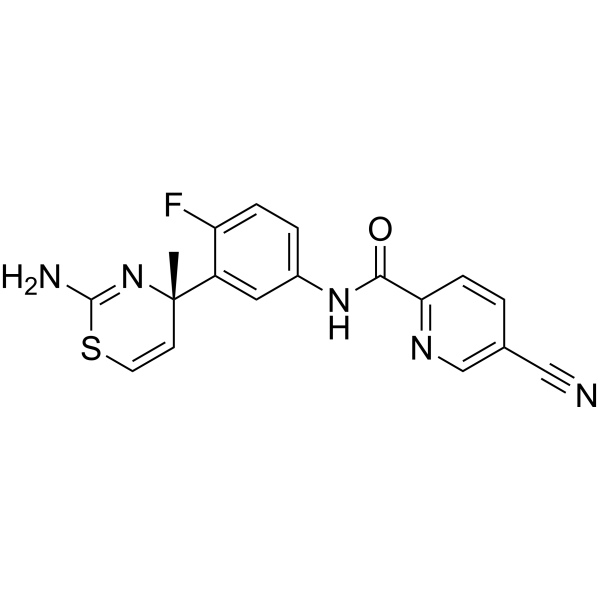
- HY-112041
-
|
PTC596
|
Apoptosis
|
Cancer
|
|
Unesbulin (PTC596) is an orally active and selective B-cell-specific Moloney murine leukemia virus integration site 1 (BMI-1) inhibitor. Unesbulin downregulates MCL-1 and induces p53-independent mitochondrial apoptosis in acute myeloid leukemia (AML) cells. Unesbulin has anti-leukemic activity .
|
-
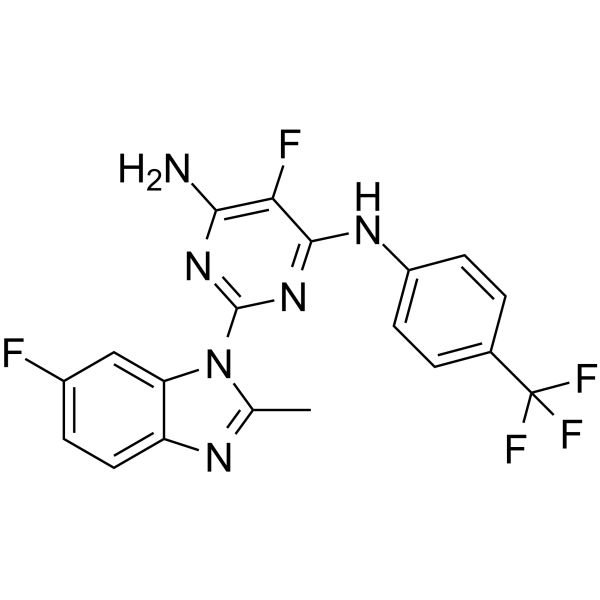
- HY-155979
-
|
|
SARS-CoV
|
Infection
|
|
SARS-CoV-2 3CLpro-IN-16 (Compound 3a) is a covalent SARS-CoV-2 3CLpro inhibitor (IC50s: 2.124 μM). SARS-CoV-2 3CLpro-IN-16 binds to the active site and forms a covalent bond with Cys145 of 3CLpro .
|
-
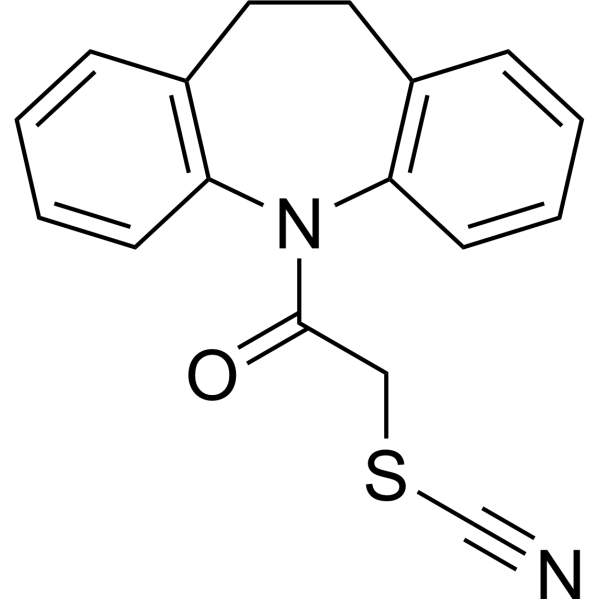
- HY-W728451
-
|
|
FAAH
|
Cardiovascular Disease
Neurological Disease
|
|
URB694 is a carbamate FAAH inhibitor that irreversibly carbamoylate the nucleophile catalytic serine in FAAH active site. URB694 exhibits antidepressant-like activity and cardioprotective effects. URB694 can be used to prepare 11C-Carbonyl-URB694 for in vivo positron emission tomography (PET) imaging studies of the brain FAAH .
|
-
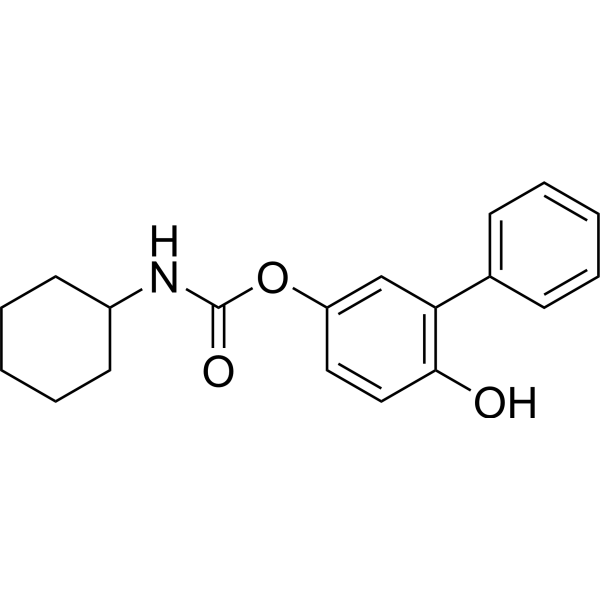
- HY-158245
-
|
|
Acetolactate Synthase (ALS)
|
Others
|
|
Herbicide safener-2 (Compound III-7) is a herbicide safener with the same pharmacokinetic profile as the safener mefenpyr-diethyl (HY-136376). Herbicide safener-2 competitively binds to the acetolactate synthase (ALS) active site with mesosulfuron-methyl (HY-126987). Herbicide safener-2 protects crops against herbicide injury .
|
-
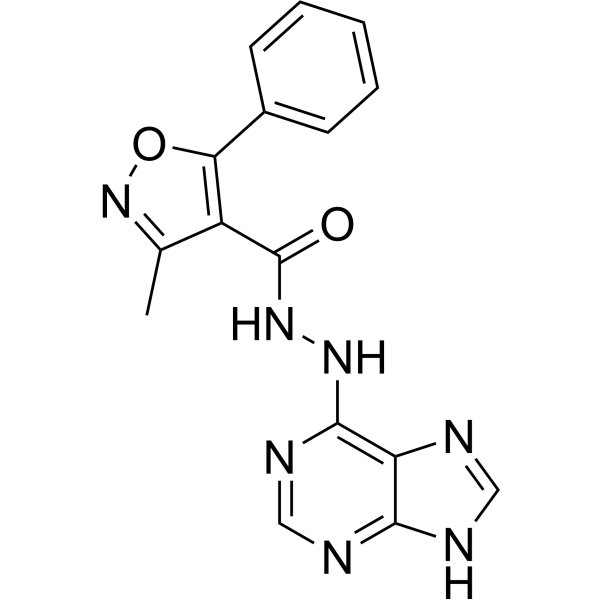
- HY-32219
-
|
|
Acyltransferase
|
Metabolic Disease
|
|
T863 is an orally active, selective and potent DGAT1 (acyl-CoA:diacylglycerol acyltransferase 1) inhibitor with an IC50 of 15 nM. T863 has no inhibitory activity against human MGAT3, human DGAT2, or human MGAT2. T863 interacts with the acyl-CoA binding site of DGAT1, and inhibits triacylglycerol synthesis in cells .
|
-

- HY-14325
-
|
|
Dopamine Receptor
|
Neurological Disease
|
|
L-745870 is a potent, selective, brain-penetrant and orally active dopamine D4 receptor antagonist with a Ki of 0.43 nM. L-745870 shows weaker affinity for D2 (Ki of 960 nM) and D3 (Ki of 2300 nM) receptors, and exhibits moderate affinity for 5-HT2 receptors, sigma sites and α-adrenoceptors .
|
-
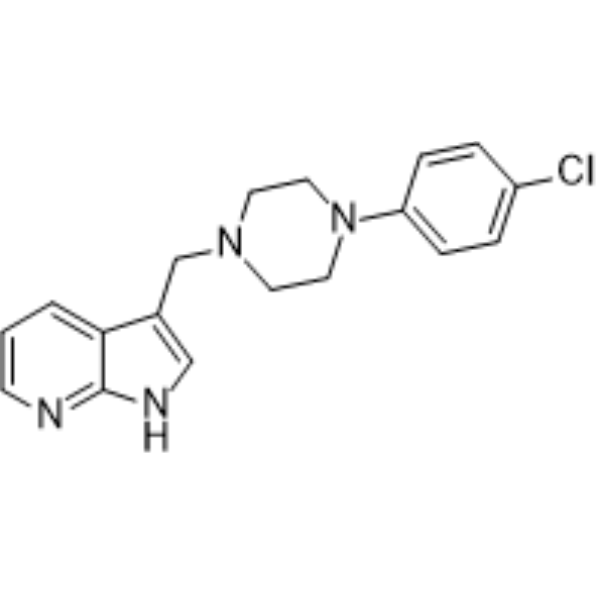
- HY-14325B
-
|
|
Dopamine Receptor
|
Neurological Disease
|
|
L-745870 hydrochloride is a potent, selective, brain-penetrant and orally active dopamine D4 receptor antagonist with a Ki of 0.43 nM. L-745870 hydrochloride shows weaker affinity for D2 (Ki of 960 nM) and D3 (Ki of 2300 nM) receptors, and exhibits moderate affinity for 5-HT2 receptors, sigma sites and α-adrenoceptors .
|
-
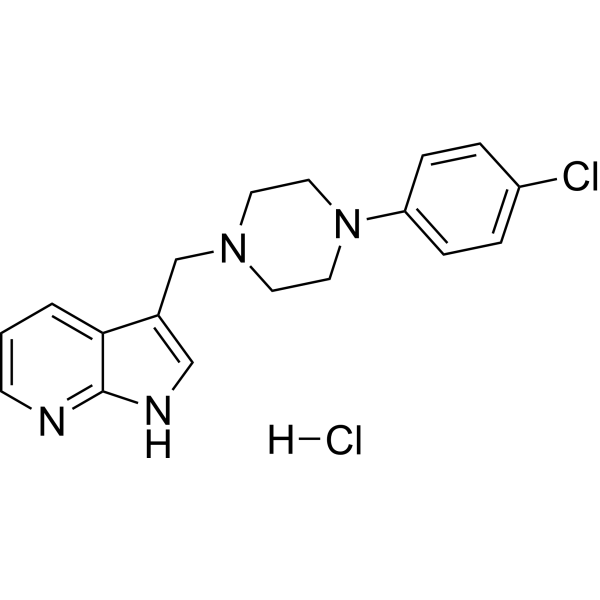
- HY-14325A
-
|
|
|
|
|
L-745870 trihydrochloride is a potent, selective, brain-penetrant and orally active dopamine D4 receptor antagonist with a Ki of 0.43 nM. L-745870 trihydrochloride shows weaker affinity for D2 (Ki of 960 nM) and D3 (Ki of 2300 nM) receptors, and exhibits moderate affinity for 5-HT2 receptors, sigma sites and α-adrenoceptors .
|
-

- HY-P3522
-
|
|
Integrin
|
Cancer
|
|
REDV is the minimal active sequence within the CS5 site of the alternatively spliced type III connecting segment (IIICS) region of fibronectin. REDV can mediate adhesion to the IIICS region of plasma fibronectin by binding the integrin alpha 4 beta 1(α4β1). REDV can be used for the research of cell adhesion .
|
-
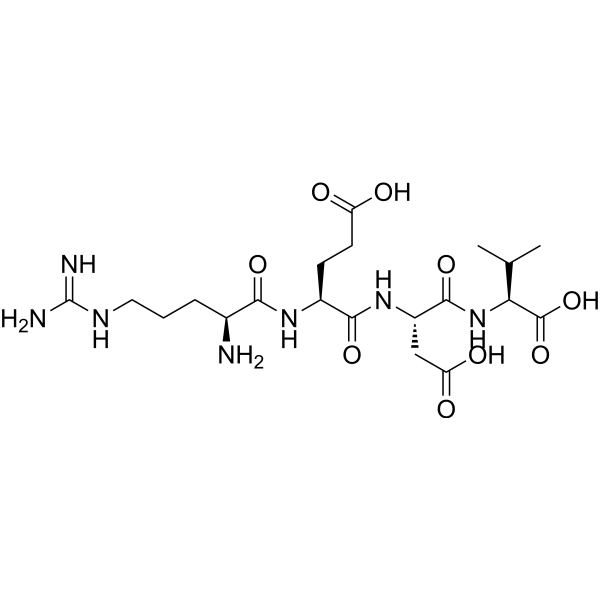
- HY-114511
-
|
|
Others
|
Cardiovascular Disease
|
|
BMS-593214 is an active site-directed factor (F) VIIa inhibitor. BMS-593214 shows antithrombotic and antihaemostatic properties. BMS-593214 is a direct competitive inhibitor of human FVIIa and a non-competitive inhibitor of Viia-activated substrate FX. BMS-593214 prevents electroinduced carotid artery thrombosis (AT) and wire induced vena cava thrombosis (VT) .
|
-
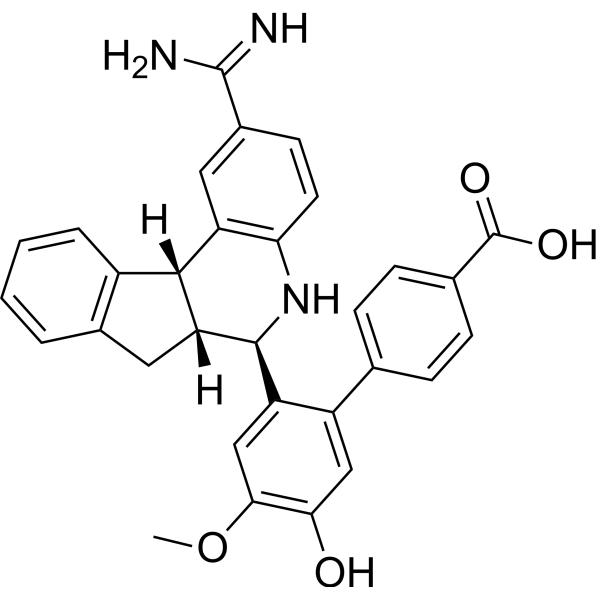
- HY-N8852
-
|
6-MeOF
|
GABA Receptor
|
Neurological Disease
|
|
6-Methoxyflavanone (6-MeOF) is an orally active flavonoid compound. 6-Methoxyflavanone has anxiolytic properties. 6-Methoxyflavanone targets unique sites on GABA-A receptors, different from traditional benzodiazepines. 6-Methoxyflavanone can be used to study anxiety disorders. 6-Methoxyflavanone readily crosses the blood brain barrier (BBB) .
|
-
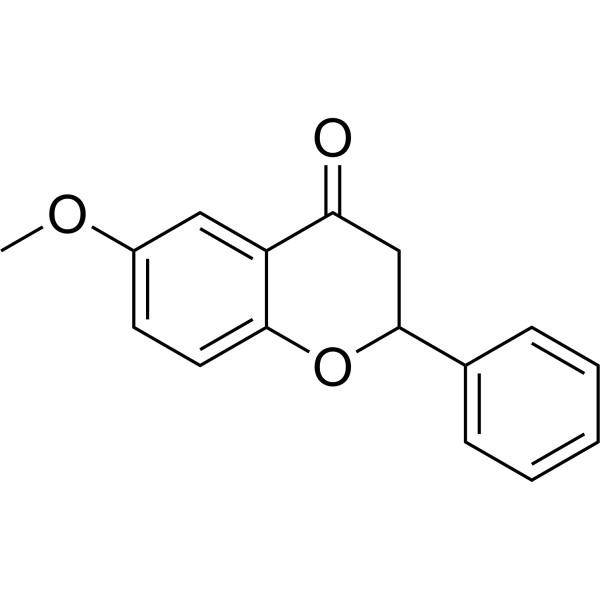
- HY-18010
-
|
|
Btk
BCRP
|
Inflammation/Immunology
|
|
PCI 29732 is a potent, orally active, reversible BTK inhibitor with Ki app values of 8.2, 4.6, and 2.5 nM for BTK, Lck and Lyn, respectively. PCI 29732 shows only modest inhibitory activity against Itk, another Tec family kinase. PCI 29732 inhibits the function of ABCG2 by competitively binding to the ATP-binding site of ABCG2 .
|
-
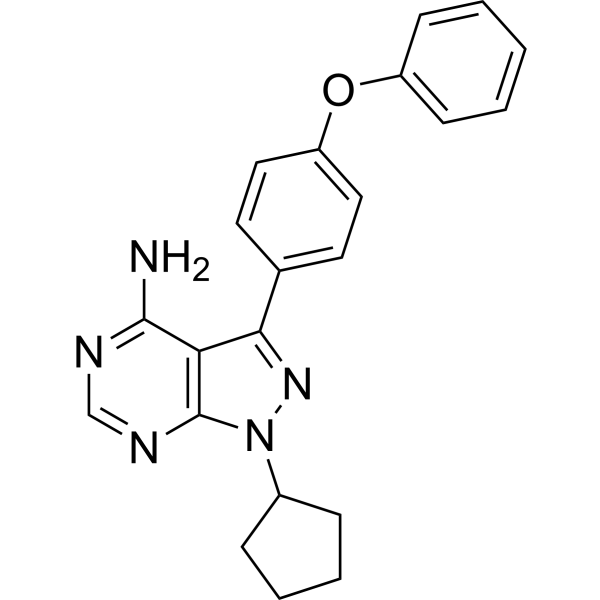
- HY-150654
-
|
|
Histone Methyltransferase
|
Cancer
|
|
WDR5-IN-5 is an orally active and selective inhibitor of WIN site of WD repeat domain 5 (WDR5). WDR5-IN-5 exhibits anti-proliferative activity towards cancer cells and good pharmacokinetics profile in mice. WDR5-IN-5 shows high affinity to WDR5 and the binding affinity Ki value <0.02 nM .
|
-

- HY-Y0958
-
|
O-Methylhydroxylamine hydrochloride
|
|
|
|
Methoxyamine (O-Methylhydroxylamine) hydrochloride is an orally active and potent base excision repair (BER) inhibitor. Methoxyamine hydrochloride binds to 3’ hydroxyl groups that are left behind by 3-methylpurine-DNA glycosylase (MPG) following excision of the damaged base and thus inhibits BER activity. Methoxyamine hydrochloride binds directly to the apyrimidinic (AP) sites. Methoxyamine hydrochloride synergistically enhances the therapeutic efficacy of DNA-damaging agents .
|
-
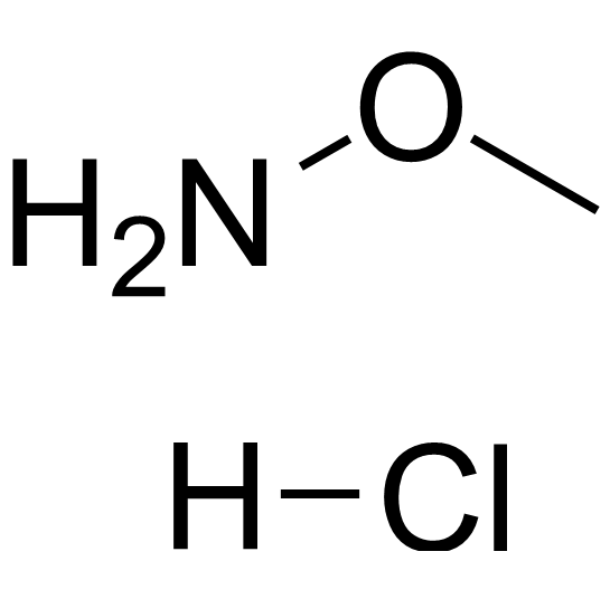
- HY-102064
-
|
|
5-HT Receptor
|
Neurological Disease
|
|
SR 57227A is a potent, orally active and selective 5-HT3 receptor agonist, with ability to cross the blood brain barrier. SR 57227A has affinities (IC50) varying between 2.8 and 250 nM for 5-HT3 receptor binding sites in rat cortical membranes and on whole NG 108-15 cells or their membranes. Anti-depressant effects .
|
-

- HY-124308
-
|
|
PKC
|
Cancer
|
|
PS315, a derivative of PS48 (HY-15967), is an allosteric PKC inhibitor by binding to the PIF-pocket of aPKC and inducing a displacement of the active site residue Lys111. PS315 inhibits the full-length and catalytic domain constructs of PKCζ (IC50=10 μM) and PKCη (IC50=30 μM). PS315 has anti-cancer activity .
|
-
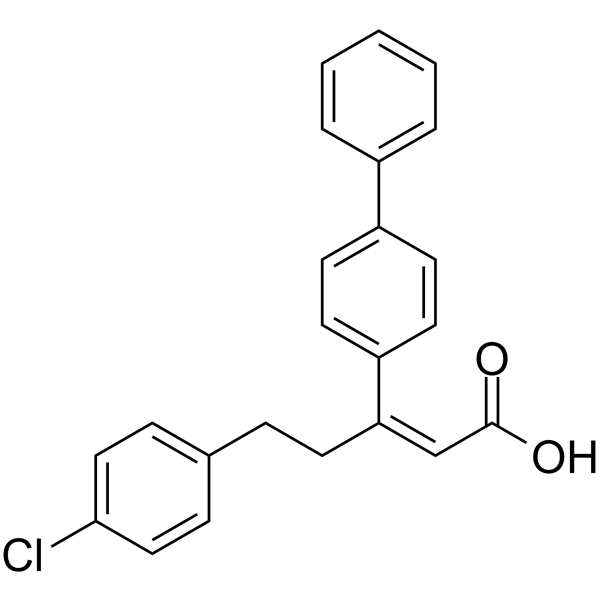
- HY-147692
-
|
|
COX
|
Inflammation/Immunology
|
|
COX-2-IN-14 (compound 2a) is a potent and selective COX-2 (cyclooxygenase-2) inhibitor. COX-2-IN-14 shows effective binding at the active site of COX-2 co-crystal. COX-2-IN-14 exhibits a high level of in vivo anti-inflammatory activity, reducing ear edema and myeloperoxidase (MPO) activity in mice .
|
-
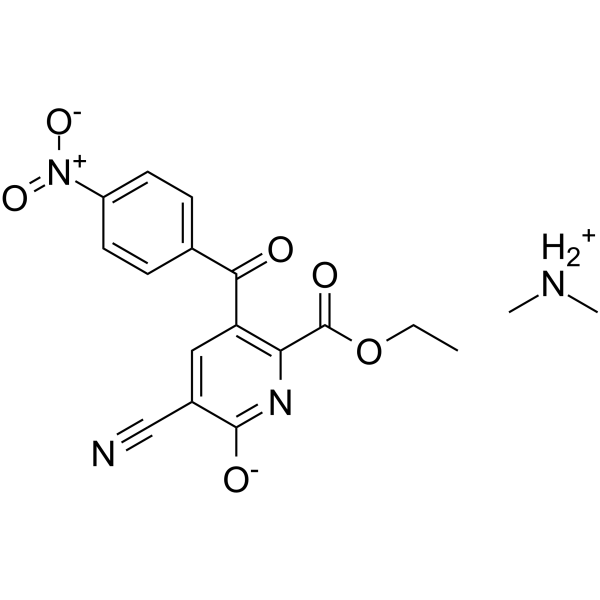
- HY-150702
-
|
|
MAGL
|
Neurological Disease
Inflammation/Immunology
|
|
MAGLi 432 is a non-covalent, potent, highly selective, and reversible MAGL inhibitor. MAGLi 432 binds with high affinity to the MAGL active site, with IC50 values of 4.2 nM (human enzyme) and 3.1 nM (mouse enzyme). MAGLi 432 can be used in the research of chronic inflammation, blood–brain barrier dysfunction, neurological disorders such as multiple sclerosis, Alzheimer’s disease and Parkinson’s disease .
|
-

- HY-152208
-
|
|
SHP2
|
Cancer
|
|
BPDA2 is a highly selective and competitive active site SHP2 inhibitor with IC50s of 92.0 nM, 33.39 μM, 40.71 μM for SHP2, SHP1, SHP1B, respectively. DBDA2 downregulates mitogenic and cell survival signaling and RTK expression. BPDA2 suppresses SHP2 mediated signaling and breast cancer cell phenotypes .
|
-
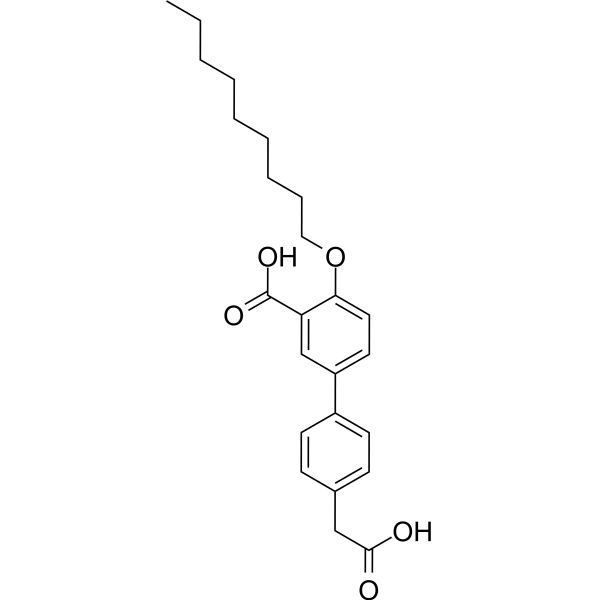
- HY-135741
-
|
|
iGluR
|
Neurological Disease
|
|
NYX-2925 is an orally active NMDAR modulator. NYX-2925 restores levels of activated Src and Src phosphorylation sites on GluN2A and GluN2B in the mPFC. NYX-2925 shows no effect on CAMKII, and any addictive or sedative/ataxic side effects. NYX-2925 can be used for research of a variety of NMDA receptor-mediated central nervous system disorders .
|
-

- HY-P3522A
-
|
|
Integrin
|
Cancer
|
|
REDV TFA is the minimal active sequence within the CS5 site of the alternatively spliced type III connecting segment (IIICS) region of fibronectin. REDV TFA can mediate adhesion to the IIICS region of plasma fibronectin by binding the integrin alpha 4 beta 1(α4β1). REDV TFA can be used for the research of cell adhesion .
|
-

- HY-11107
-
|
|
c-Met/HGFR
Autophagy
Apoptosis
|
Cancer
|
|
PHA-665752 is a selective, ATP-competitive, and active-site inhibitor of the catalytic activity of c-Met kinase (Ki=4 nM; IC50=9 nM). PHA-665752 exhibits >50-fold selectivity for c-Met compared with a panel of diverse tyrosine and serine-threonine kinases. PHA-665752 induces apoptosis and cell cycle arrest, and exhibits cytoreductive antitumor activity .
|
-
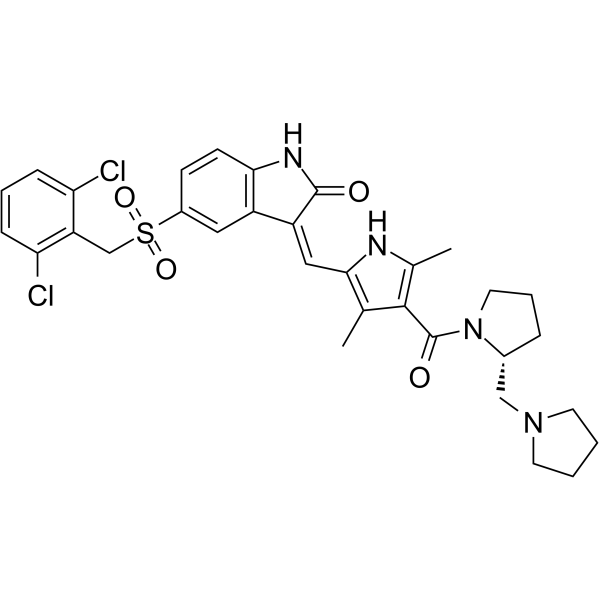
- HY-P5525
-
|
Autocamtide-3 Derived Inhibitory Peptide
|
CaMK
|
Others
|
|
AC3-I, myristoylated is a biological active peptide. (This is a myristoylated form of Autocamtide-3-Derived Inhibitory Peptide (AC3-I), a highly specific inhibitor of Calmodulin-Dependent Protein Kinase ll (CaMKII) that is resistant to proteolysis. AC3-I is derived from Autocamtide-3, a substrate for CaMKII, with the Thr-9 phosphorylation site substituted with Ala.)
|
-
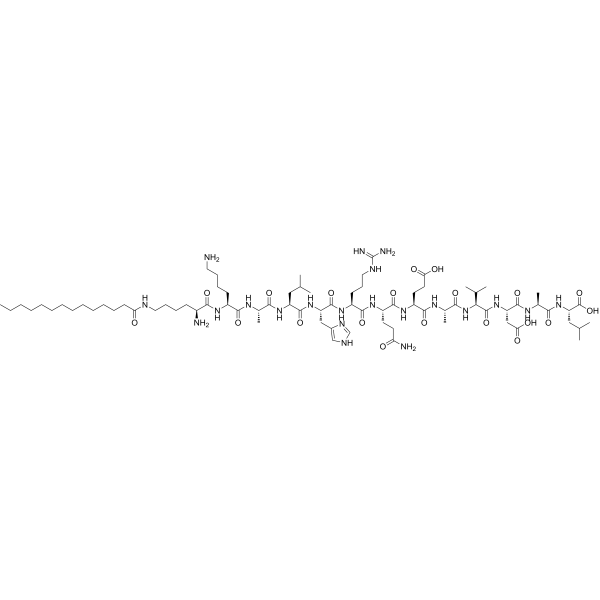
- HY-156737
-
|
|
Microtubule/Tubulin
|
Cancer
|
|
Tubulin polymerization-IN-49 (compound 12d) is a potent tubulin polymerization inhibitor. Tubulin polymerization-IN-49 bound to colchicine site on tubulin and inhibited tubulin polymerization. Tubulin polymerization-IN-49 induces cell cycle arrest at G2/M phase and apoptosis. Tubulin polymerization-IN-49 has anticancer active and prevents tumor generation, inhibits tumor proliferation and angiogenesis .
|
-
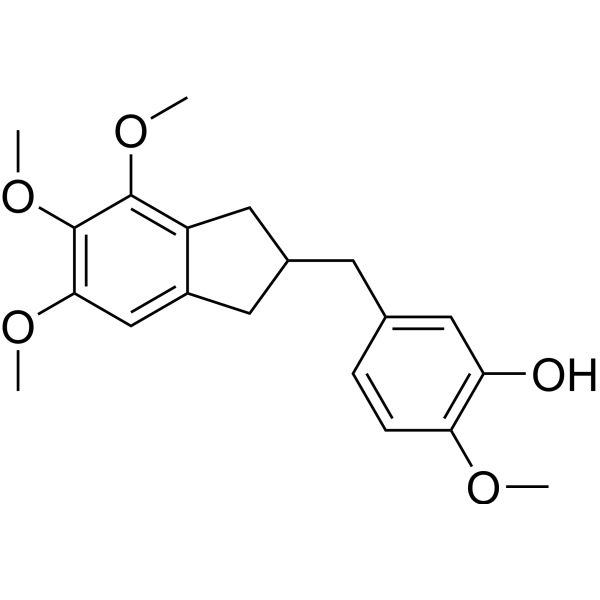
- HY-13240
-
|
|
Beta-secretase
|
Neurological Disease
|
|
LY2886721 is a potent, selective and orally active beta-site amyloid precursor protein cleaving enzyme 1 (BACE1) inhibitor with an IC50 of 20.3 nM for recombinant human BACE1. LY2886721 is selectivity against cathepsin D, pepsin, and renin, but lacking selectivity against BACE2 (IC50 of 10.2 nM). LY2886721 can across blood-brain barrier and has the potential for Alzheimer's disease treatment .
|
-

- HY-14336A
-
|
SB 271046A
|
5-HT Receptor
|
Neurological Disease
|
|
SB 271046 Hydrochloride (SB 271046A) is a potent, selective and orally active 5-HT6 receptor antagonist with pKi of 9.02, 8.55, and 8.81 for rat, pig and human, respectively. SB 271046 Hydrochloride is over 200 fold selective for the 5-HT6 receptor vs 55 other receptors, binding sites and ion channels. Anticonvulsant activity (EC50=0.16 μM) .
|
-
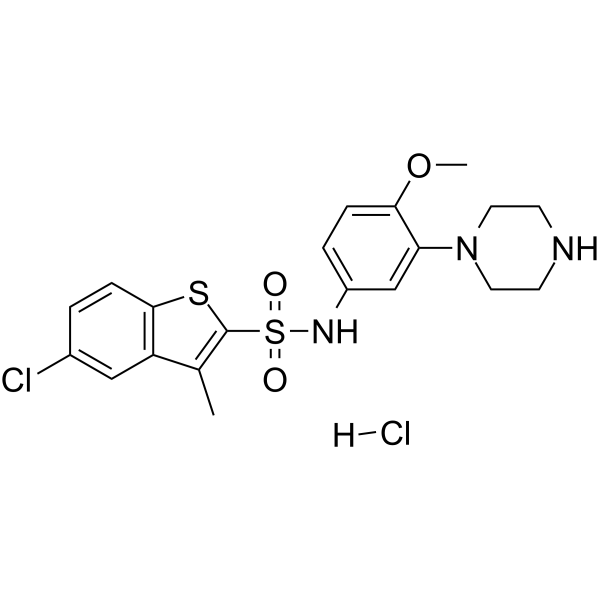
- HY-P1906
-
|
|
CDK
|
Neurological Disease
|
|
[pThr3]-CDK5 Substrate is an effective Phospho-Thr3CDK5 Substrate. [pThr3]-CDK5 Substrate is derived from the sequence of the histone H1 peptide that docks in the active site of CDK5. [pThr3]-CDK5 Substrate is phosphorylated by CDK5 with a Km value of 6 µM .
|
-
![[pThr3]-CDK5 Substrate](//file.medchemexpress.com/product_pic/hy-p1906.gif)
- HY-P1906A
-
|
|
CDK
|
Neurological Disease
|
|
[pThr3]-CDK5 Substrate TFA is an effective Phospho-Thr3CDK5 Substrate. [pThr3]-CDK5 Substrate is derived from the sequence of the histone H1 peptide that docks in the active site of CDK5. [pThr3]-CDK5 Substrate is phosphorylated by CDK5 with a Km value of 6 µM .
|
-
![[pThr3]-CDK5 Substrate TFA](//file.medchemexpress.com/product_pic/hy-p1906a.gif)
- HY-103565
-
|
|
mGluR
|
Neurological Disease
|
|
AMN082, a selective, orally active, and brain penetrant mGluR7 agonist, directly activates receptor signaling via an allosteric site in the transmembrane domain. AMN082 potently inhibits cAMP accumulation and stimulates GTPγS binding (EC50 values, 64-290 nM) at transfected mammalian cells expressing mGluR7. AMN082 shows selectivity over other mGluR subtypes and selected ionotropic glutamate receptors. Antidepressant effects .
|
-
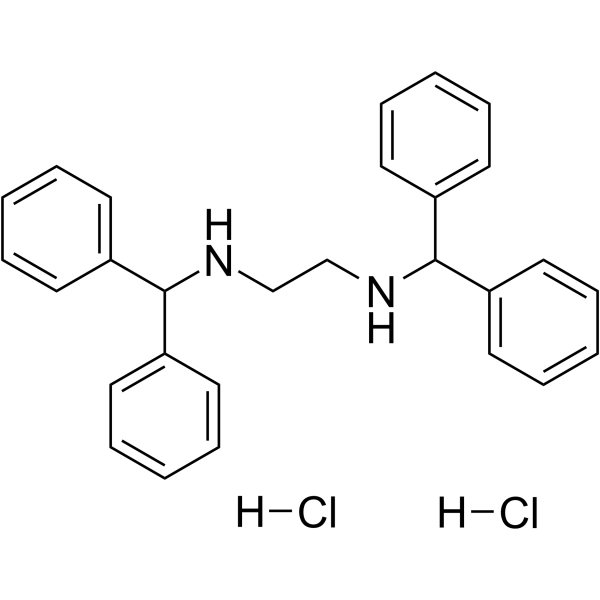
- HY-13240A
-
|
|
Beta-secretase
|
Neurological Disease
|
|
LY2886721 hydrochloride is a potent, selective and orally active beta-site amyloid precursor protein cleaving enzyme 1 (BACE1) inhibitor with an IC50 of 20.3 nM for recombinant human BACE1. LY2886721 hydrochloride is selectivity against cathepsin D, pepsin, and renin, but lacking selectivity against BACE2 (IC50 of 10.2 nM). LY2886721 hydrochloride can across blood-brain barrier and has the potential for Alzheimer's disease treatment .
|
-
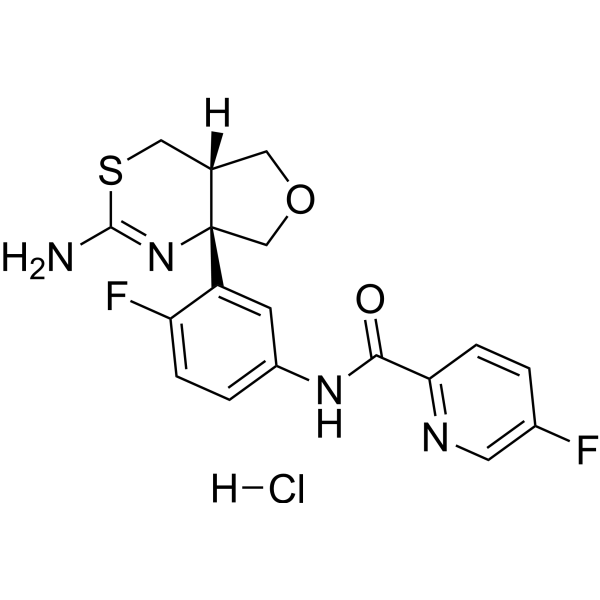
- HY-128774
-
|
|
Beta-secretase
|
Neurological Disease
|
|
AM-6494 is a potent and orally active BACE1 (efficacious β-site amyloid precursor protein cleaving enzyme 1) inhibitor (IC50=0.4 nM) with in vivo selectivity over BACE2 (IC50=18.6 nM) . AM-6494 is a click chemistry reagent, it contains an Alkyne group and can undergo copper-catalyzed azide-alkyne cycloaddition (CuAAc) with molecules containing Azide groups.
|
-

- HY-P4322
-
|
|
ERK
Akt
|
Neurological Disease
Cancer
|
|
H-Ile-Lys-Val-Ala-Val-OH is one of the most potent active sites of laminin-1. H-Ile-Lys-Val-Ala-Val-OH promotes cell adhesion, neurite outgrowth, and tumor growth. H-Ile-Lys-Val-Ala-Val-OH stimulates BMMSC population growth and proliferation by activating MAPK/ERK1/2 and PI3K/Akt signalling pathways .
|
-
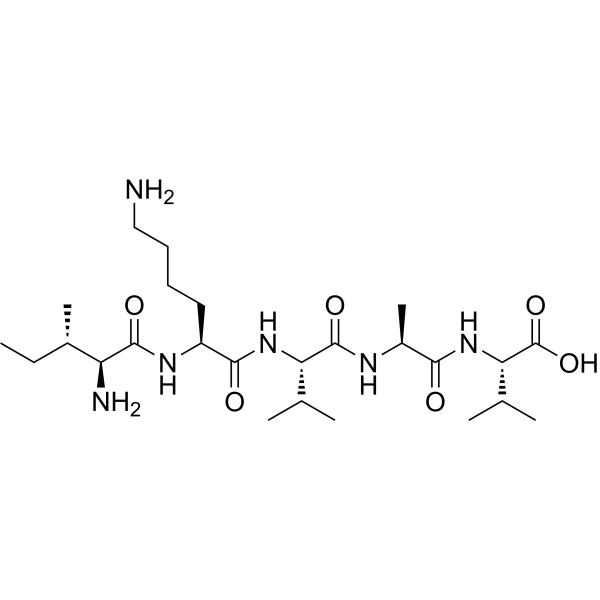
- HY-149350
-
|
|
HIV
|
Infection
|
|
HIV-1 inhibitor-57 (Compound 12g) is a HIV inhibitor. HIV-1 inhibitor-57 is active against wild-type and five prevalent NNRTI-resistant HIV-1 strains with EC50 values ranging from 0.024 to 0.0010 μM. HIV-1 inhibitor-57 forms additional interactions with residues around the binding site in HIV-1 RT .
|
-
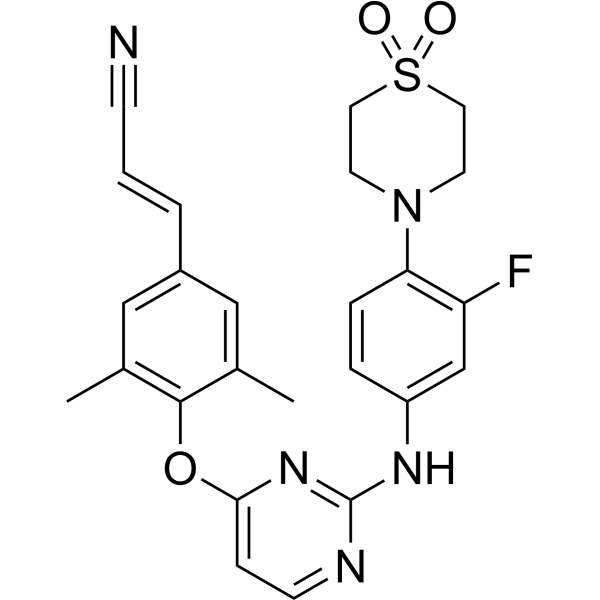
- HY-123587A
-
|
|
Others
|
Cancer
|
|
(R)-PR-924 is the isomer of PR-924 (HY-123587), and can be used as an experimental control. PR-924 is a selective tripeptide epoxyketone immunoproteasome subunit LMP-7 inhibitor with an IC50 of 22 nM. PR-924 covalently modifies proteasomal N-terminal threonine active sites. PR-924 inhibits growth and triggers apoptosis in multiple myeloma (MM) cells. PR-924 has antitumor activities .
|
-
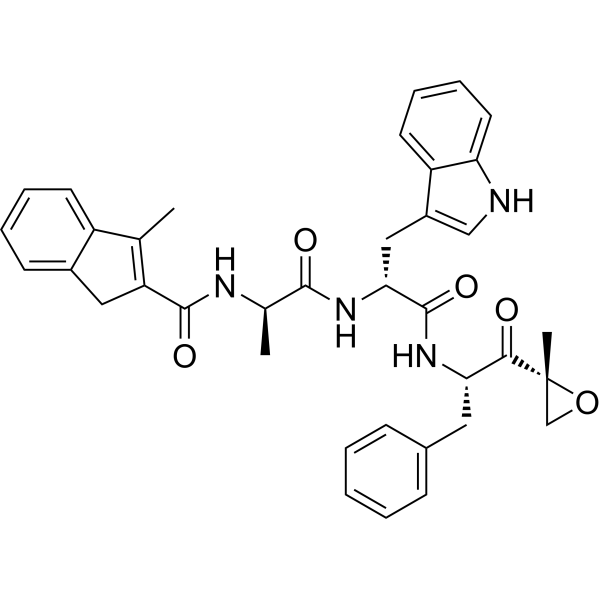
- HY-161324
-
|
|
Microtubule/Tubulin
|
Cancer
|
|
Tubulin degrader 1 (Compound 5i) is a BML284 (HY-19987) derivative that is an orally active colchicine-site noncovalent tubulin degradation agent with IC50 values ranging from 0.02 to 0.05 μM against the five tumor cell lines (Hela, HCT116, MCF-7, K562 and Molm-13). Tubulin degrader 1 has antiproliferative activity that effectively suppressed tumor growth .
|
-
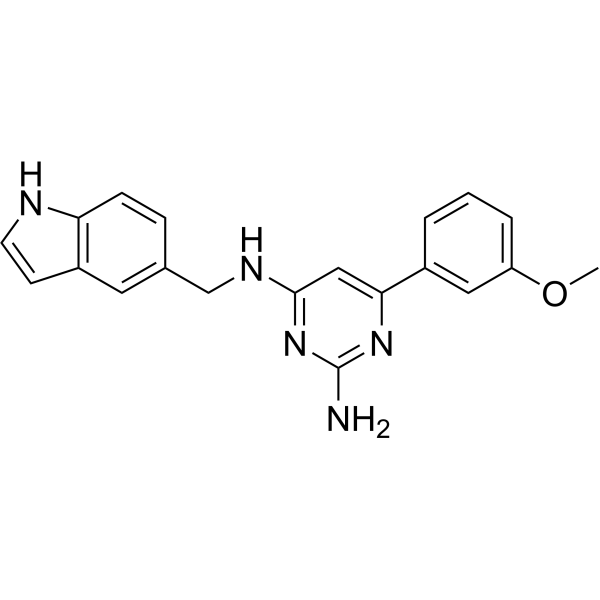
- HY-128206
-
I3MT-3
4 Publications Verification
HMPSNE
|
Hippo (MST)
|
Metabolic Disease
|
|
I3MT-3 (HMPSNE) is a potent, selective, and cell-membrane permeable inhibitor of 3-Mercaptopyruvate sulfurtransferase (3MST) (IC50=2.7 μM). I3MT-3 is inactive for other H2S/sulfane sulfur-producing enzymes. I3MT-3 targets a persulfurated cysteine residue located in the active site of 3MST .
|
-

- HY-123981
-
|
|
Phosphatase
|
Cancer
|
|
5MPN is a first-in-class, potent, orally active and selective 6-phosphofructo-2-kinase/fructose-2,6-bisphosphatase 4 (PFKFB4) inhibitor. 5MPN appears to be a competitive inhibitor of the F6P binding site (Ki=8.6 μM). 5MPN does not inhibit PFK-1 or PFKFB3. 5MPN targets the sugar metabolism of tumors and suppresses proliferation of multiple human cancer cell lines .
|
-

- HY-115531
-
|
|
Others
|
Cancer
|
|
UNC-2170 is a functionally active, fragment-like ligand for 53BP1 (IC50=29 µM; Kd=22 µM). UNC-2170 shows at least 17-fold selectivity for 53BP1 as compared to nine other methyl-lysine (Kme) reader proteins. 53BP1 is a Kme binding protein that plays a central role in DNA Damage Repair (DDR) pathways and is recruited to sites of double-strand breaks (DSB) .
|
-
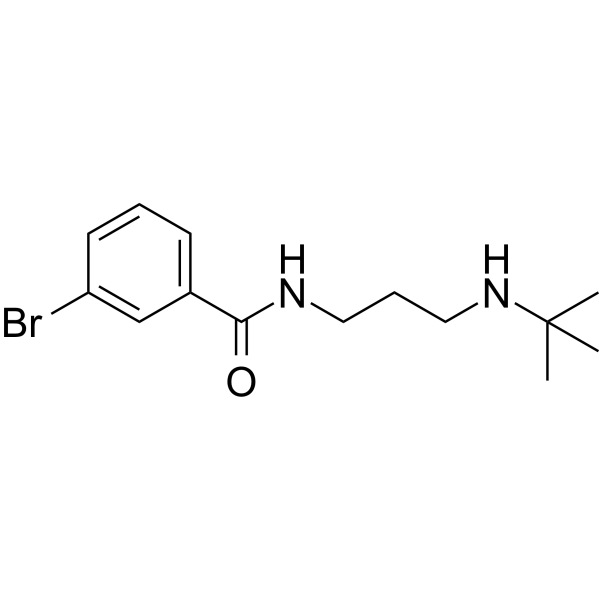
- HY-103565A
-
|
|
mGluR
|
Neurological Disease
|
|
AMN082 free base, a selective, orally active, and brain penetrant mGluR7 agonist, directly activates receptor signaling via an allosteric site in the transmembrane domain. AMN082 free base potently inhibits cAMP accumulation and stimulates GTPγS binding (EC50 values, 64-290 nM) at transfected mammalian cells expressing mGluR7. AMN082 free base shows selectivity over other mGluR subtypes and selected ionotropic glutamate receptors. Antidepressant effects .
|
-
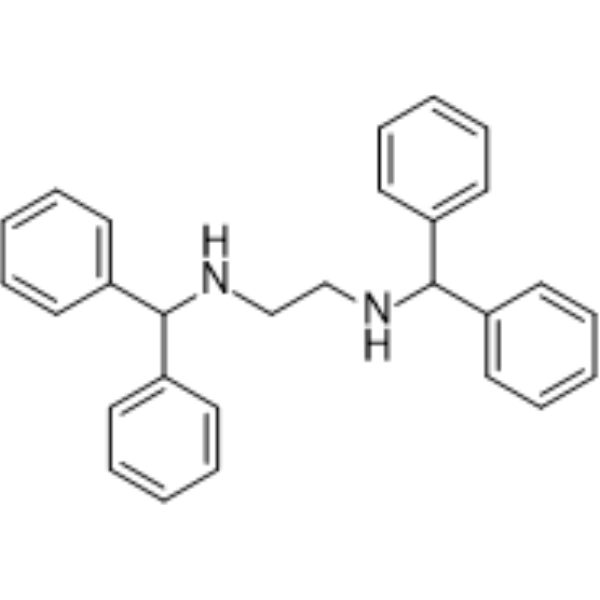
- HY-129284
-
|
|
COX
|
Cancer
|
|
APHS is a specific and covalent COX-2 inhibitor with neuroprotective effects. COX-2 is a prostaglandin (PG) synthetase overexpressed in colorectal cancer (CRC) and has pleiotropic cancer-promoting effects. APHS modifies COX-2 by acetylating the active site (serine 516), thereby inhibiting prostaglandin production. The neuroprotective activity of APHS is inhibited by prostaglandin E2. APHS also co-inhibits the WNT pathway, an anti-tumor mechanism in addition to COX-2 inhibition .
|
-

- HY-122587
-
|
|
DNA/RNA Synthesis
RSV
|
Infection
|
|
AVG-233 is a potent, orally active RNA dependent RNA polymerase (RdRp) inhibitor. AVG-233 prevents initiation of the viral polymerase complex at the promoter. AVG-233 binding site is present in the L1-1749 fragment. AVG-233 has nanomolar activity against both RSV strains and clinical RSV isolates (EC50=0.14-0.31 μM). AVG-233 can be used for research of respiratory syncytial virus (RSV) .
|
-
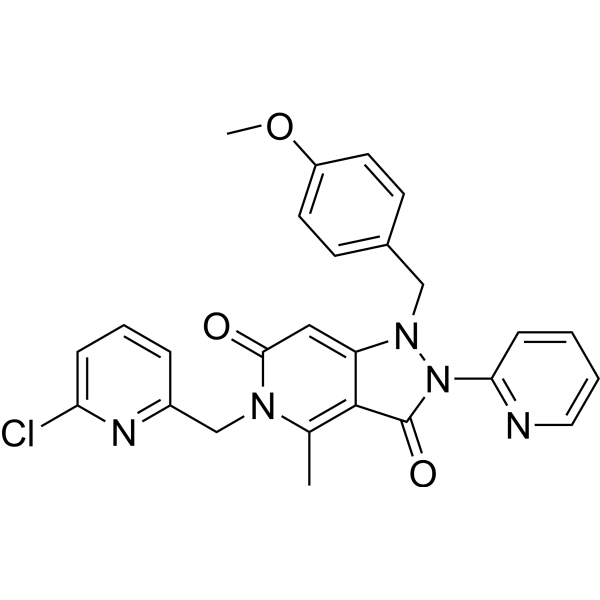
- HY-P5395
-
|
|
HIV
|
Others
|
|
TAT-GluR23A Fusion Peptide is a biological active peptide. (This is the GluR23A sequence, a control inactive peptide used as a mutant counterpart to glutamate receptor endocytosis inhibitor (GluR23Y), connected to an 11 amino acid cell permeable HIV Trans-Activator of Transcription (TAT) protein transduction domain (PTD). GluR23A is derived from GluR23Y amino acids 869 to 877, with Ala substituted for Tyr, and thus lacking essential phosphorylation sites.Control peptide of HY-P2259)
|
-

- HY-149579
-
|
|
Glucosidase
|
Metabolic Disease
|
|
α-Glucosidase-IN-36 (compound 5g) is a potent α-glucosidase inhibitor, with an IC50 of 6.69 ± 0.18 μM, Ki and Kis of 1.65 μM and 4.54 μM, respectively. α-Glucosidase-IN-36 may inhibit α-glucosidase activity by binding with its active site as well as changing the secondary structure of α-glucosidase. α-Glucosidase-IN-36 can be used for type 2 diabetes mellitus (T2DM) research .
|
-
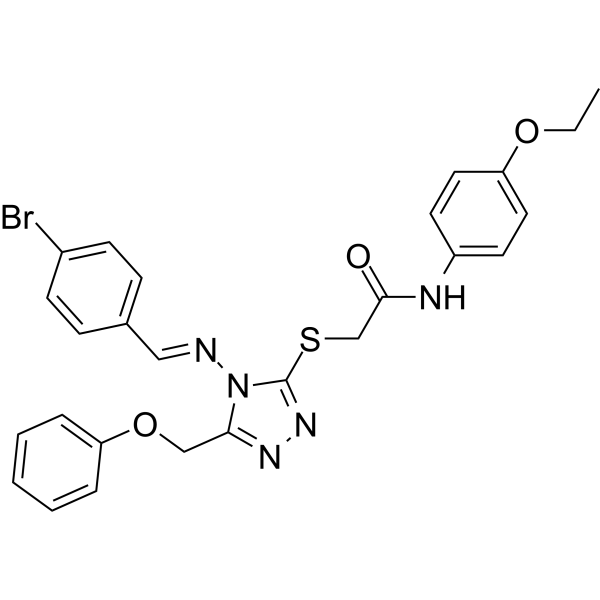
- HY-112306
-
|
DCC-2618
|
c-Kit
PDGFR
FLT3
VEGFR
Apoptosis
|
Cancer
|
|
Ripretinib (DCC-2618) is an orally bioavailable, selective KIT and PDGFRA switch-control inhibitor. Ripretinib (DCC-2618) targets and binds to both wild-type and mutant forms of KIT and PDGFRA specifically at their switch pocket binding sites, thereby preventing the switch from inactive to active conformations of these kinases and inactivating their wild-type and mutant forms. Ripretinib (DCC-2618) also inhibits multiple other kinase targets, such as FLT3 and KDR (or VEGFR-2) . DCC-2618 exerts antineoplastic effect and induces apoptosis .
|
-
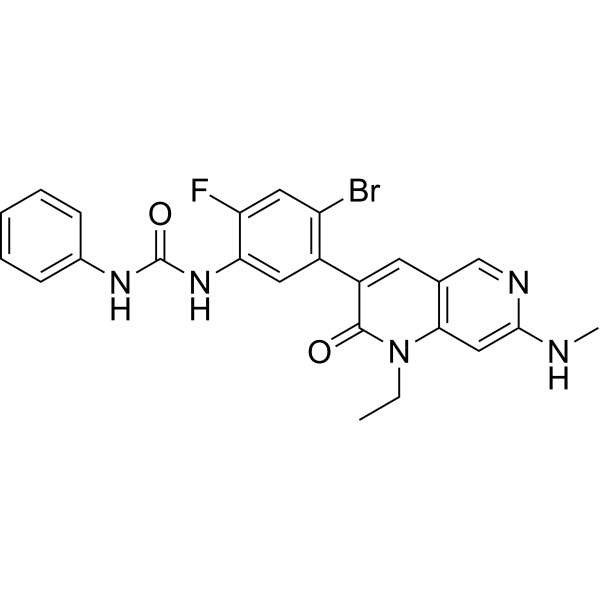
- HY-B1455
-
|
|
|
|
|
Clindamycin is an orally active and broad-spectrum bacteriostatic lincosamide antibiotic. Clindamycin can inhibit bacterial protein synthesis, possessing the ability to suppress the expression of virulence factors in Staphylococcus aureus at sub-inhibitory concentrations (sub-MICs). Clindamycin resistance results from enzymatic methylation of the antibiotic binding site in the 50S ribosomal subunit (23S rRNA). Clindamycin decreases the production of Panton-Valentine leucocidin (PVL), toxic-shock-staphylococcal toxin (TSST-1) or alpha-haemolysin (Hla). Clindamycin also can be used for researching malaria .
|
-

- HY-12545
-
|
PbTx-3
|
Sodium Channel
|
Inflammation/Immunology
|
|
Brevetoxin-3 (PbTx-3) is a potent allosteric voltage-gated Na + channel activator and has multiple active centers (A-ring lactone, C-42 of R side chain) . Brevetoxin-3 (PbTx-3) has a high affinity to site 5 of the voltage-sensitive Na + channels, inhibits the inactivation of Na + channels and prolongs the mean open time of these channels. Brevetoxin-3 (PbTx-3) repeated exposures can lead to prolonged airway hyperresponsiveness (AHR) and lung inflammation .
|
-

- HY-14604
-
|
SR57746A; SR57746 hydrochloride
|
5-HT Receptor
Dopamine Receptor
|
Neurological Disease
|
|
Xaliproden hydrochloride (SR57746A) is a potent, selective and orally active agonist of 5-HT1A receptor, shows a high affinity for 5-HT1A specific binding sites in the rat hippocampus (IC50=3 nM). Xaliproden hydrochloride is also a selective antagonist of dopamine D2 receptor, has moderate affinity (IC50=0.1-1 μM). Xaliproden hydrochloride exhibits anti-depression and anti-anxiety effects, and it may possess therapeutic potential for the research of neurodegenerative diseases .
|
-
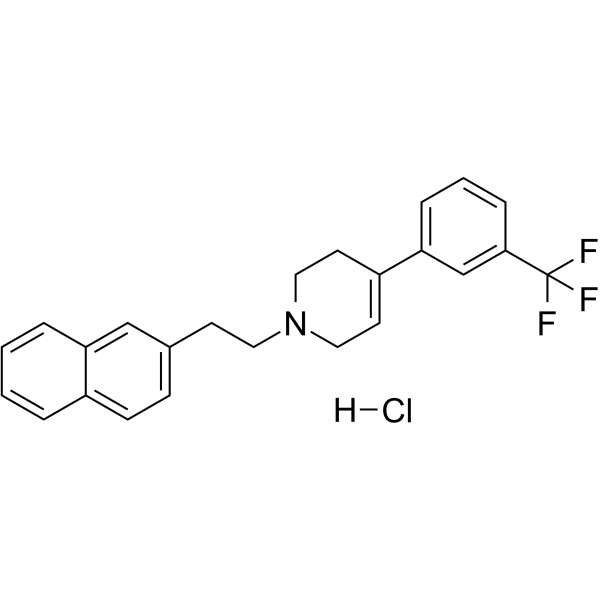
- HY-127102
-
|
DDD01305143
|
Parasite
Proteasome
|
Infection
|
|
GSK3494245 (DDD01305143) is a potent, orally active, and selective inhibitor of the chymotrypsin-like activity of the parasite proteasome binding in a site sandwiched between the β4 and β5 subunits (IC50=0.16 μM for WT L. donovani proteasomes). GSK3494245 moderately inhibits chymotrypsin-like activity of human proteasome (IC50: purified 26S=13 µM; enriched THP-1 extracts IC50=40µM). GSK3494245 exhibits attractive biological and biosafety properties .
|
-
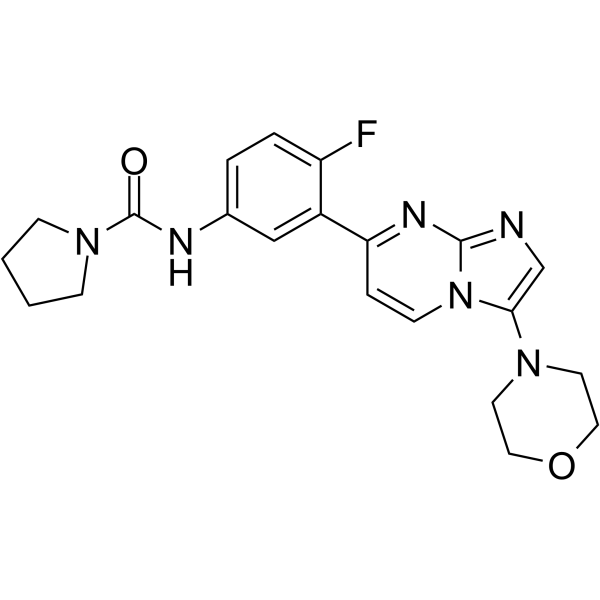
- HY-158028
-
|
|
Influenza Virus
|
Infection
|
|
PAN endonuclease-IN-2 (compound T-31) is a PAN endonuclease inhibitor (IC50: 0.15 μM) and antiviral agent with broad-spectrum anti- Influenza activity. PAN is the N-terminal PA subunit of the polymerase-RNA complex and the dependent endonuclease (CEN) active site. PAN initiates RNA replication by promoting cleavage of the RNA strand and allowing the polymerase to begin synthesizing new RNA molecules. PAN endonuclease-IN-2 targets both the influenza HA and RdRp complexes, thereby interfering with viral entry into host cells and viral replication .
|
-
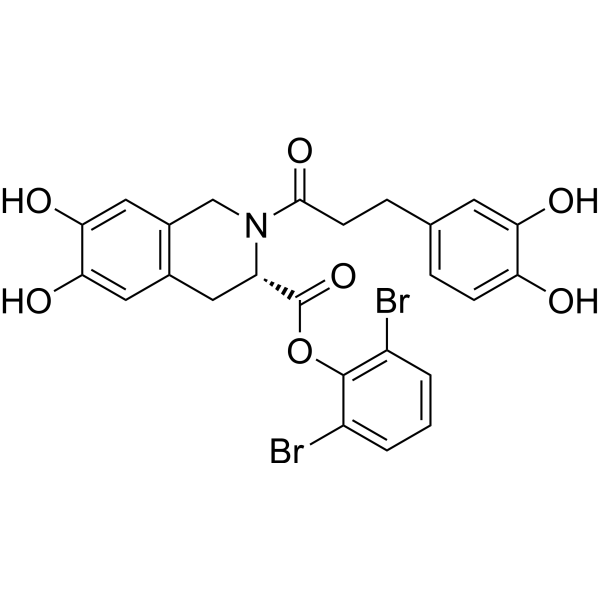
- HY-B1455S
-
|
|
Bacterial
Antibiotic
Parasite
|
Infection
|
|
Clindamycin-d3 (hydrochloride) is the deuterium labeled Clindamycin. Clindamycin is an orally active and broad-spectrum bacteriostatic lincosamide antibiotic. Clindamycin can inhibit bacterial protein synthesis, possessing the ability to suppress the expression of virulence factors in Staphylococcus aureus at sub-inhibitory concentrations (sub-MICs). Clindamycin resistance results from enzymatic methylation of the antibiotic binding site in the 50S ribosomal subunit (23S rRNA). Clindamycin decreases the production of Panton-Valentine leucocidin (PVL), toxic-shock-staphylococcal toxin (TSST-1) or alpha-haemolysin (Hla). Clindamycin also can be used for researching malaria[1][2].
|
-

- HY-101343
-
|
|
5-HT Receptor
|
Neurological Disease
|
|
RS 39604 is a potent, selective, and orally active 5-HT4 receptor antagonist with a pKi of 9.1 in guinea pig striatal membranes. RS 39604 displays a low affinity (pKi<6.5) for 5-HT1A, 5-HT2C, 5-HT3, α1c, D1, D2, M1, M2, AT1, B1 and opioid mu receptors and moderate affinity for δ1, (pKi=6.8) and δ2 (pKi=7.8) sites .
|
-
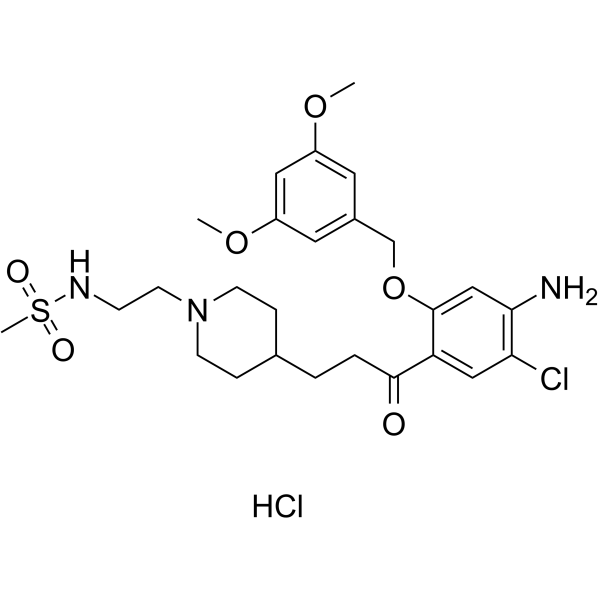
- HY-B1455S1
-
|
|
Isotope-Labeled Compounds
Bacterial
Antibiotic
Parasite
|
Infection
|
|
Clindamycin- 13C,d3 is the 13C- and deuterium labeled Clindamycin. Clindamycin is an orally active and broad-spectrum bacteriostatic lincosamide antibiotic. Clindamycin can inhibit bacterial protein synthesis, possessing the ability to suppress the expression of virulence factors in Staphylococcus aureus at sub-inhibitory concentrations (sub-MICs). Clindamycin resistance results from enzymatic methylation of the antibiotic binding site in the 50S ribosomal subunit (23S rRNA). Clindamycin decreases the production of Panton-Valentine leucocidin (PVL), toxic-shock-staphylococcal toxin (TSST-1) or alpha-haemolysin (Hla). Clindamycin also can be used for researching malaria[1][2][3].
|
-

| Cat. No. |
Product Name |
Type |
-
- HY-115749A
-
|
(Rac)-6′-Methoxyluciferin sodium
|
Fluorescent Dyes/Probes
|
|
D-Luciferin 6′-methyl ether (6′-Methoxyluciferin; compound 19a) sodium is a potent luciferase from the North American firefly Photinus pyralis (PpyLuc) inhibitor with an IC50 of 0.1 μM. D-Luciferin 6′-methyl ether, a D-luciferin analog, shows non-specific interactions at ATP- and luciferin-binding sites of the PpyLuc active site .
|
| Cat. No. |
Product Name |
Target |
Research Area |
-
- HY-P2463
-
|
|
Arp2/3 Complex
|
Inflammation/Immunology
|
|
Fequesetide, a peptide segment, is the active site within the protein thymosin β4 responsible for actin binding, cell migration and wound healing .
|
-
- HY-P4508
-
|
|
Peptides
|
Others
|
|
SIGSLAK has the active site of E. coli penicillin-binding protein 1b .
|
-
- HY-P4552
-
|
|
Peptides
|
Others
|
|
Hippuryl-Phe-Arg-OH is the active site on the cell surface of Angiotensin I converting enzyme (ACE) .
|
-
- HY-P5343
-
|
p53 Consensus binding sequence
|
MDM-2/p53
|
Others
|
|
p53 CBS (p53 Consensus binding sequence) is a biological active peptide. (p53 consensus DNA binding site)
|
-
- HY-P5466
-
|
|
Peptides
|
Others
|
|
S6(229-239) is a biological active peptide. (This is a synthetic peptide substrate for S6 kinase shown to be phosphorylated by protein kinase c with phosphorylation site identified at Ser235)
|
-
- HY-P5434
-
|
JAK3 Peptide substrate
|
Peptides
|
Others
|
|
Jak3tide (JAK3 Peptide substrate) is a biological active peptide. (This peptide is a substrate for Jak3. It may be used used in kinase assays. Jak3tide contains the phosphorylation site at Tyr7.)
|
-
- HY-P5455
-
|
|
LIM Kinase (LIMK)
|
Others
|
|
S3 Fragment is a biological active peptide. (This peptide contains the unique amino-terminal phosphorylation site of Xenopus ADF/cofilin, the LIM kinase (LIMK) phosphorylation site. LIMK1 is a key regulator of the actin cytoskeleton through its phosphorylation of ADF/cofilin at serine-3 for inactivation. This peptide is a fragment of the S3 peptide containing the serine-3 sequence of ADF/cofilin that has been widely used as an effective competitive inhibitor of LIMK1.)
|
-
- HY-P5427
-
|
|
Peptides
|
Others
|
|
EAC3I is a biological active peptide. (The autocamtide-3 derived inhibitory peptide (EAC3I) sequence (KKALHRQEAVDAL) mimics the autoinhibitory region of the CaMKII regulatory domain (residues 278–290) and acts by competitively binding to the catalytic site.)
|
-
- HY-P0266B
-
|
Ac-SDKP acetate
|
Angiotensin-converting Enzyme (ACE)
|
Inflammation/Immunology
|
|
N-Acetyl-Ser-Asp-Lys-Pro (Ac-SDKP) acetate is a specific substrate for the N-terminal active site of angiotensin-converting enzyme (ACE). N-Acetyl-Ser-Asp-Lys-Pro acetate is a natural inhibitor of pluripotent hematopoietic stem cell proliferation. Anti-inflammatory and antifibrotic properties .
|
-
- HY-P5323
-
|
|
Peptides
|
Others
|
|
Dabcyl-AGHDAHASET-Edans is a biological active peptide. (This is a type I signal peptidase (SPase1) substrate peptide labeled with EDANS/ DABCYL FRET pair, and contains a crucial cleavage site derived from the C-terminal region of the Staphylococcus epidermidis pre-SceD protein. Abs/Em = 340/490 nm.)
|
-
- HY-P5350
-
|
|
Peptides
|
Others
|
|
FN-A208 is a biological active peptide. (This peptide is a fusion of A208, derived from murine laminin a1, and the active site of fibronectin (GRGDS), with a glycine spacer. This peptide forms amyloid-like fibrils and promotes formation of actin stress fibers that mediate fibroblast cell attachment, offering it potential as a bioadhesive for tissue regeneration and engineering. FN-A208 interacts with IKVAV receptors and integrins. Its activity is disrupted by the presence of EDTA.)
|
-
- HY-P3522
-
|
|
Integrin
|
Cancer
|
|
REDV is the minimal active sequence within the CS5 site of the alternatively spliced type III connecting segment (IIICS) region of fibronectin. REDV can mediate adhesion to the IIICS region of plasma fibronectin by binding the integrin alpha 4 beta 1(α4β1). REDV can be used for the research of cell adhesion .
|
-
- HY-P3522A
-
|
|
Integrin
|
Cancer
|
|
REDV TFA is the minimal active sequence within the CS5 site of the alternatively spliced type III connecting segment (IIICS) region of fibronectin. REDV TFA can mediate adhesion to the IIICS region of plasma fibronectin by binding the integrin alpha 4 beta 1(α4β1). REDV TFA can be used for the research of cell adhesion .
|
-
- HY-P5525
-
|
Autocamtide-3 Derived Inhibitory Peptide
|
CaMK
|
Others
|
|
AC3-I, myristoylated is a biological active peptide. (This is a myristoylated form of Autocamtide-3-Derived Inhibitory Peptide (AC3-I), a highly specific inhibitor of Calmodulin-Dependent Protein Kinase ll (CaMKII) that is resistant to proteolysis. AC3-I is derived from Autocamtide-3, a substrate for CaMKII, with the Thr-9 phosphorylation site substituted with Ala.)
|
-
- HY-P1906
-
|
|
CDK
|
Neurological Disease
|
|
[pThr3]-CDK5 Substrate is an effective Phospho-Thr3CDK5 Substrate. [pThr3]-CDK5 Substrate is derived from the sequence of the histone H1 peptide that docks in the active site of CDK5. [pThr3]-CDK5 Substrate is phosphorylated by CDK5 with a Km value of 6 µM .
|
-
- HY-P1906A
-
|
|
CDK
|
Neurological Disease
|
|
[pThr3]-CDK5 Substrate TFA is an effective Phospho-Thr3CDK5 Substrate. [pThr3]-CDK5 Substrate is derived from the sequence of the histone H1 peptide that docks in the active site of CDK5. [pThr3]-CDK5 Substrate is phosphorylated by CDK5 with a Km value of 6 µM .
|
-
- HY-P5508
-
|
|
Peptides
|
Others
|
|
MUC5AC-13 is a biological active peptide. (This glycopeptide is an N-acetyl galactosamine (GalNAc)-modified MUC5AC mucin peptide containing the single site of threonine 13 labeled with GalNAc (T*). Polypeptide N-acetylgalactosaminyltransferase (ppGaNTase) catalyzes the transfer of GalNAc from the nucleotide sugar UDP-GalNAc to threonine. The MUC5AC gene is mainly expressed in gastric and tracheo-bronchial mucosae, and some tumors.)
|
-
- HY-P5513
-
|
|
Peptides
|
Others
|
|
Aquaporin-2 (254-267), pSER261, human is a biological active peptide. (This peptide is a fragment of the human aquaporin-2 (AQP2) phosphorylated at Ser261. Protein phosphorylation plays a key role in vasopressin signaling in renal-collecting duct. Phosphorylation at several AQP2 residues including Ser256 and Ser261, is altered in response to vasopressin. It is possible that both sites are involved in vasopressin-dependent AQP2 trafficking.)
|
-
- HY-P4322
-
|
|
ERK
Akt
|
Neurological Disease
Cancer
|
|
H-Ile-Lys-Val-Ala-Val-OH is one of the most potent active sites of laminin-1. H-Ile-Lys-Val-Ala-Val-OH promotes cell adhesion, neurite outgrowth, and tumor growth. H-Ile-Lys-Val-Ala-Val-OH stimulates BMMSC population growth and proliferation by activating MAPK/ERK1/2 and PI3K/Akt signalling pathways .
|
-
- HY-P5395
-
|
|
HIV
|
Others
|
|
TAT-GluR23A Fusion Peptide is a biological active peptide. (This is the GluR23A sequence, a control inactive peptide used as a mutant counterpart to glutamate receptor endocytosis inhibitor (GluR23Y), connected to an 11 amino acid cell permeable HIV Trans-Activator of Transcription (TAT) protein transduction domain (PTD). GluR23A is derived from GluR23Y amino acids 869 to 877, with Ala substituted for Tyr, and thus lacking essential phosphorylation sites.Control peptide of HY-P2259)
|
-
- HY-P5415
-
|
|
Peptides
|
Others
|
|
DABCYL-GABA-Ser-Gln-Asn-Tyr-Pro-Ile-Val-Gln-EDANS is a biological active peptide. (DABCYL-GABA-Ser-Gln-Asn-Tyr-Pro-Ile-Val-Gln-EDANS is also called HIV protease substrate I in some literature. It is widely used for the continuous assay for HIV protease activity. The 11-kD protease (PR) encoded by the human immunodeficiency virus 1 (HIV-1) is essential for the correct processing of viral polyproteins and the maturation of infectious virus, and is therefore a target for the design of selective acquired immunodeficiency syndrome (AIDS) therapeutics. The FRET-based fluorogenic substrate is derived from a natural processing site for HIV-1 PR. Incubation of recombinant HIV-1 PR with the fluorogenic substrate resulted in specific cleavage at the Tyr-Pro bond and a time-dependent increase in fluorescence intensity that is linearly related to the extent of substrate hydrolysis. The fluorescence quantum yields of the HIV-1 PR substrate in the FRET assay increased by 40.0- and 34.4-fold, respectively, per mole of substrate cleaved. Because of its simplicity and precision in the determination of reaction rates required for kinetic analysis, this substrate offers many advantages over the commonly used HPLC or electrophoresis-based assays for peptide substrate hydrolysis by retroviral PRs. Abs/Em = 340nm/490nm.)
|
| Cat. No. |
Product Name |
Target |
Research Area |
-
- HY-P99283
-
|
NN 7415; mAb 2021; Anti-TFPI Recombinant Antibody
|
Inhibitory Antibodies
|
Others
|
|
Concizumab is an anti-TFPI monoclonal antibody (IgG4 type) that binds to the Kunitz-type protease inhibitor (KPI) 2 structural domain of TFPI, thereby blocking the interaction of this structural domain with the FXa active site. Concizumab can be used in the study of haemophilia .
|
-
- HY-P99298
-
|
RG 7417; TNX 234; Anti-CFD Recombinant Antibody
|
Complement System
|
Inflammation/Immunology
|
|
Lampalizumab (RG 7417) is a humanised monoclonal antibody targeting complement Factor D in the alternative complement pathway. Lampalizumab binds an exosite and sterically blocks Factor B access to the active site. Lampalizumab can be used for age-related macular degeneration (AMD) research .
|
| Cat. No. |
Product Name |
Category |
Target |
Chemical Structure |
| Cat. No. |
Product Name |
Chemical Structure |
-
- HY-B1455S1
-
|
|
|
Clindamycin- 13C,d3 is the 13C- and deuterium labeled Clindamycin. Clindamycin is an orally active and broad-spectrum bacteriostatic lincosamide antibiotic. Clindamycin can inhibit bacterial protein synthesis, possessing the ability to suppress the expression of virulence factors in Staphylococcus aureus at sub-inhibitory concentrations (sub-MICs). Clindamycin resistance results from enzymatic methylation of the antibiotic binding site in the 50S ribosomal subunit (23S rRNA). Clindamycin decreases the production of Panton-Valentine leucocidin (PVL), toxic-shock-staphylococcal toxin (TSST-1) or alpha-haemolysin (Hla). Clindamycin also can be used for researching malaria[1][2][3].
|
-

-
- HY-15345AS
-
|
|
|
Tetrahydrouridine-d3 is the deuterium labeled Tetrahydrouridine[1]. Tetrahydrouridine dihydrate is potent inhibitor of cytidine deaminase (CDA), which competitively blocks the enzyme's active site more effectively than intrinsic cytidine[2][3].
|
-

-
- HY-B1455S
-
|
|
|
Clindamycin-d3 (hydrochloride) is the deuterium labeled Clindamycin. Clindamycin is an orally active and broad-spectrum bacteriostatic lincosamide antibiotic. Clindamycin can inhibit bacterial protein synthesis, possessing the ability to suppress the expression of virulence factors in Staphylococcus aureus at sub-inhibitory concentrations (sub-MICs). Clindamycin resistance results from enzymatic methylation of the antibiotic binding site in the 50S ribosomal subunit (23S rRNA). Clindamycin decreases the production of Panton-Valentine leucocidin (PVL), toxic-shock-staphylococcal toxin (TSST-1) or alpha-haemolysin (Hla). Clindamycin also can be used for researching malaria[1][2].
|
-

| Cat. No. |
Product Name |
|
Classification |
-
- HY-100433
-
|
|
|
Alkynes
|
|
PACMA 31 is an irreversible, orally active protein disulfide isomerase (PDI) inhibitor with an IC50 of 10 μM. PACMA 31 forms a covalent bond with the active site cysteines of PDI. PACMA 31 shows tumor targeting ability and significantly suppresses ovarian tumor growth without causing toxicity to normal tissues . PACMA 31 is a click chemistry reagent, it contains an Alkyne group and can undergo copper-catalyzed azide-alkyne cycloaddition (CuAAc) with molecules containing Azide groups.
|
-
- HY-132913
-
|
|
|
Alkynes
|
|
Cyclopropenone probe 1 can specifically and efficiently modify a triple-negative breast cancer driver, glutathione S-transferase pi-1 (GSTP1), by covalently binding at the catalytic active site. Cyclopropenone probe 1 is a click chemistry reagent, it contains an Alkyne group and can undergo copper-catalyzed azide-alkyne cycloaddition (CuAAc) with molecules containing Azide groups.
|
-
- HY-128774
-
|
|
|
Alkynes
|
|
AM-6494 is a potent and orally active BACE1 (efficacious β-site amyloid precursor protein cleaving enzyme 1) inhibitor (IC50=0.4 nM) with in vivo selectivity over BACE2 (IC50=18.6 nM) . AM-6494 is a click chemistry reagent, it contains an Alkyne group and can undergo copper-catalyzed azide-alkyne cycloaddition (CuAAc) with molecules containing Azide groups.
|
Your information is safe with us. * Required Fields.
Inquiry Information
- Product Name:
- Cat. No.:
- Quantity:
- MCE Japan Authorized Agent:










































































































![[pThr3]-CDK5 Substrate](http://file.medchemexpress.com/product_pic/hy-p1906.gif)
![[pThr3]-CDK5 Substrate TFA](http://file.medchemexpress.com/product_pic/hy-p1906a.gif)


























